
The Project Gutenberg EBook of Devils Tower National Monument, Wyoming, by National Park Service This eBook is for the use of anyone anywhere in the United States and most other parts of the world at no cost and with almost no restrictions whatsoever. You may copy it, give it away or re-use it under the terms of the Project Gutenberg License included with this eBook or online at www.gutenberg.org. If you are not located in the United States, you'll have to check the laws of the country where you are located before using this ebook. Title: Devils Tower National Monument, Wyoming Author: National Park Service Release Date: January 1, 2019 [EBook #58587] Language: English Character set encoding: UTF-8 *** START OF THIS PROJECT GUTENBERG EBOOK DEVILS TOWER NATIONAL MONUMENT *** Produced by Stephen Hutcheson and the Online Distributed Proofreading Team at http://www.pgdp.net

Devils Tower National Monument
Wyoming
Produced by the
Division of Publications
National Park Service
U.S. Department of the Interior
Washington, D.C. 1984
National Park Handbooks, compact introductions to the great natural and historic places administered by the National Park Service, are designed to promote understanding and enjoyment of the parks. Each is intended to be informative reading and a useful guide before, during, and after a park visit. More than 100 titles are in print. This is Handbook 111. You may purchase the handbooks through the mail by writing to Superintendent of Documents, U.S. Government Printing Office, Washington DC 20402.
Devils Tower National Monument is in the Black Hills of northeastern Wyoming. The major attractions are the volcanic rock Tower and protected prairie dog communities. This handbook is published in support of the National Park Service’s management policies and interpretive programs at the park. Part 1 of the handbook gives a brief introduction to the park and its history; Part 2 takes a close look at the area’s natural history and, in particular, prairie dogs; and Part 3 presents concise travel guide and reference materials.
Main entry under title:

Rising nearly straight up from the plains, Devils Tower accentuates the differences in the scale of life. The snow-dusted, volcanic sentinel dwarfs the forest at its base.
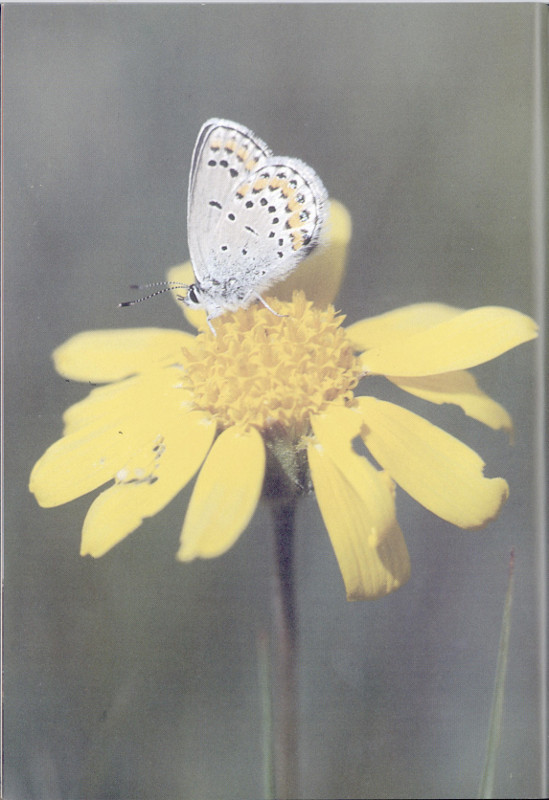
Smaller still, and requiring our closer look in different seasons, are butterflies, flowers, and, below, pine seedlings.
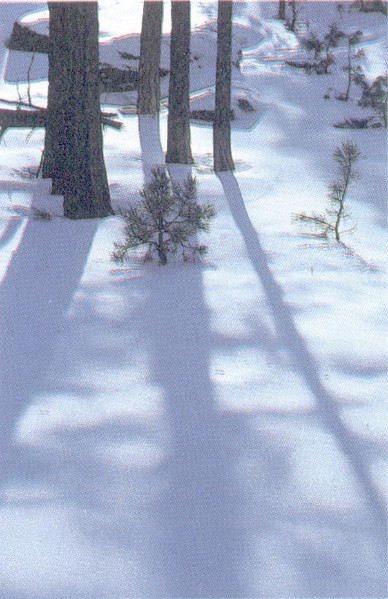
Devils Tower rises dramatically and abruptly out of the Black Hills above the Belle Fourche River in northeastern Wyoming. These Black Hills are an island in the Great Plains, the heart of the American West. The aura of this West and of its history, folklore, and legend is a fondly nurtured American treasure. Never just The West, it is rather the Scenic West, or the Old West, or the True West, and of course the Wild West. Each epithet suggests that no one can pay homage to the region without resorting to its curious mixture of the known and the unknown, of truth and myth. Here is a land of blue skies, magnificent rock formations, and a clear, dry atmosphere that easily confuses and distorts your sense of distance. It is a land of mountain views, long probing rivers, deserts, and high plains and space—great unfathomable oceans of space. The West is the archetypal outdoors whose recreation possibilities forever grip the modern imagination.
A trip to Devils Tower National Monument is a trip to Wyoming, a state fully proud of its Western traditions. Car license plates display the bucking bronco to advertise “the land of the cowboy,” a motif repeated in many public places and widely observed in the casual manner of its people.
A trip to Devils Tower is also a trip to the Black Hills, an island of life rising out of the more arid Great Plains. Devils Tower sits on the Black Hills’ western fringe and is in fact the area’s most remarkable landmark. The Tower still evokes the mystery of this land where whites feared to travel until as late as 1876, the year General George Armstrong Custer and his cavalry fought—and were annihilated—in the battle of the Little Big Horn River in Montana. This last great victory of the Sioux and Cheyenne who refused reservation life made them hunted outlaws among whites. Their relatives on reservations soon gave away the tribal lands and with this went the Indians’ last hope of remaining free to travel and hunt from their revered Black Hills base.
To speak of history in Wyoming is to speak of a mere hundred years. Events in the settlement are so recent that many residents can recite them as part of their family history. Before that are the 10 oral histories of the Sioux, Cheyenne, Shoshone, Crow, and other tribes whose dates of occupation are but vaguely known.
Gold discoveries in today’s South Dakota portion of the Black Hills forced the final clash with the plains tribes. Custer had confirmed gold reports and the pressure of the excited rush that followed broke the government’s earlier treaty resolve to preserve forever the Indians’ sovereignty over the Black Hills.
Settlers carrying American civilization to the West by the overland route to California, Oregon Territory, and Mormon Utah then quickly flowed into this backwater area. As the frenzied furor over Black Hills gold diminished and mines and creeks played out, homesteaders settled on lands parceled out for ranches. Along the Belle Fourche River, where the plains Indian tribes had sometimes spent winters, a new era opened under this brooding tower of rock called Mateo Tepee.
Place names in the West can be powerfully suggestive of history, but they can also be very unreliable; Devils Tower for instance. To the Indians this singular occurrence of dramatically upthrust rock marked the dwelling place of bears, hence Mateo Tepee or “Bear Lodge.” Their stories told of lost youngsters who were chased by a giant bear and climbed on top of a rock in a last desperate effort to save themselves. The children appealed to the spirits and the rock grew up out of the ground to lift the children out of the giant bear’s reach. Versions of this story belong to different tribes, but most have in common the bear’s futile attempt to claw its way to the top. This clawing left permanent grooves on the Tower.
Colonel Richard I. Dodge apparently had not heard these stories when he entered the Black Hills in 1875. In charge of a large military escort to a scientific team, he came in violation of Indian treaty rights after Custer’s 1874 expedition which had reported gold. Dodge noted that his questions to the Indians about this “terra incognita” known as the Black Hills were met with “studied silence.” This only heightened a true explorer’s curiosity. Perhaps the Indian scouts affected a calculated silence, hoping the whites would leave. When the great rock tower first loomed in sight, they told 11 Dodge it was named, “with proper modification by our surveyors,” the Devils Tower. In later years few could recall why this name was used.
If it was meant to scare off these white explorers and those to follow, it did not. The new wave of American settlers did not believe that natural objects held supernatural powers. No matter how awesome or unusual, science had an explanation for everything in nature, or would eventually. Devils Tower was determined to be the core of an ancient volcano, an obelisk of volcanic trachyte, with sides so straight that one “could only look upward in despair of ever planting his feet on the top,” as one geologist in Dodge’s expedition put it.
The desire to conquer and tame nature, the view that men could use up natural things and discard them without asking the spirits, differed greatly from Indian concepts. While the tools and equipment of an advanced civilization could not be resisted, the explanation white men gave for their world could never satisfy the Indians. How uncomfortable it must have been for them when they were asked to relate their tribal stories of places such as Mateo Tepee, about which there could be no “proof!” One day a man would find a way to plant his feet on top of Devils Tower, and it would be hailed as a personal feat of strength and daring having nothing to do with the spirit of the bear that dwelt within his lodge.
In the 20-year period after the opening of the Black Hills, cowmen and sheepherders discovered the hilly prairies and spacious grasslands that spread from the Belle Fourche River as far west as the Big Horn Mountains. Cattle trailed up from Texas flourished into great herds that freely roamed the open range. The Chicago, Burlington & Quincy Railroad extended its line from Nebraska northwestward to Gillette, which quickly became the system’s largest shipping point. As many as 12,000 beef cattle and 40,000 head of sheep at a time waited at the railroad to be sent to eastern meatpackers. Wyoming became a state in 1890, its history already indelibly colored by the cowboy lifestyle and territorial range feuds.
Cowboy songs and stories of Western American folklore often mentioned the Belle Fourche River. The first ranchers to settle along it established small-scale cattle outfits centered about Hulett within sight of Devils Tower. These early-day settlers may not 12 have revered the Tower as the Indians did, but neither were they disposed to see it exploited for private gain. There was enough feeling to cause Wyoming’s Senator Francis E. Warren to introduce into the U.S. Senate in July of 1892 a bill to establish Devils Tower National Park. Congressional support for the bill fizzled, but the General Land Office in Washington had already withdrawn from settlement several sections of land adjoining the Tower and the Little Missouri Buttes to the northwest. Protection of Devils Tower was at least temporarily assured.
The same year the park bill failed, two men now famous in the history of the West traveled to Devils Tower hoping against hope like any other tourists that it would match their own expectations. Photographer William H. Jackson had been commissioned by the State of Wyoming to photograph the State’s scenic attractions for the World’s Columbian Exposition the next year in Chicago. With him traveled a friend, the landscape painter Thomas Moran. Their round trip from the railhead at Gillette, by horse-drawn wagon lasted four days. Moran described the adventure in a magazine article illustrated by his drawings, and a Jackson photo of the Tower ended up in Chicago. In their one afternoon there, they had produced the first widely known visual records of Devils Tower.
Jackson and Moran’s unceremonious visit to the Tower in 1892 was undoubtedly forgotten in the rush of excitement the next year. Homesteaders, ranchers, and cowhands and their families flocked in unusual numbers to celebrate Independence Day at Devils Tower. Handbills called the Tower one of the greatest natural wonders in the United States and announced that “the rarest sight of a lifetime” would be observed at the festivities. The news obviously spread far, for more than 1,000 people made the trip.
The ballyhoo surrounded William Rogers. A local cowboy, he became, as far as anybody knew, the first human being to set foot on top of the Tower. He and a climbing partner, Willard Ripley, made the ascent by way of a wooden ladder they had worked on all that spring for the first 107 meters (350 feet) of the Tower. Those who knew the tall and raw-boned Rogers said he was never afraid of man or devil. After ceremonies on the ground, he and Ripley scrambled over the boulder field and started up the ladder with the cheers of the crowd presumably ringing in their ears. The climb took only an hour, the riskiest part of the business having been accomplished in the days preceding the event.
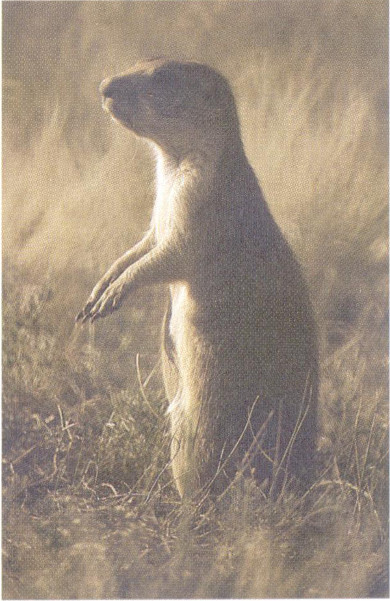
While the Tower draws our eyes upward, playful prairie dogs invite us to look downward—to their burrows on the level grassland between the Tower and the Belle Fourche River.
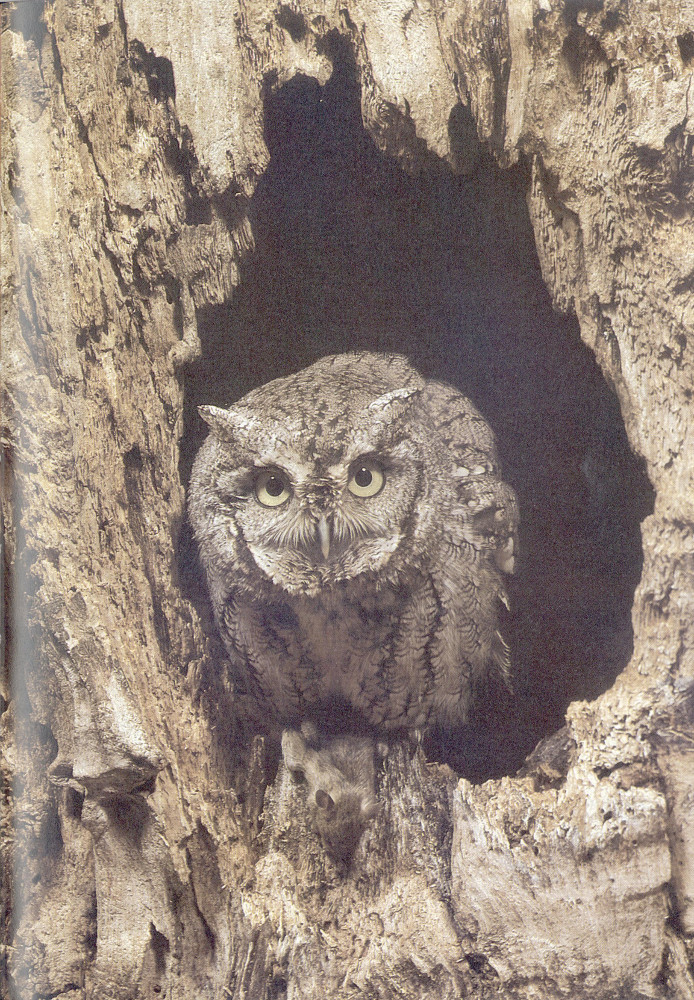
These communal animals are forever on the alert against such predators as the screech owl.
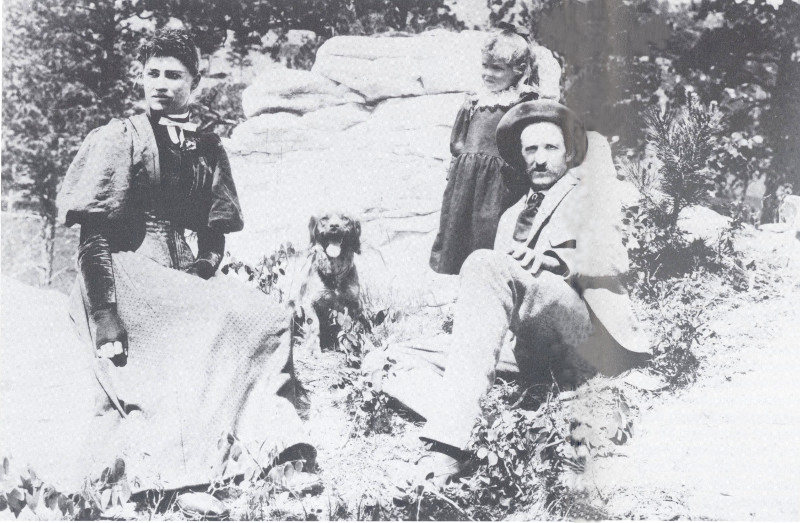
William Rogers, above right, relaxes at the Tower with his wife, stepdaughter, and dog. Rogers and Willard Ripley, the first persons to climb to the summit, had driven wooden pegs into a vertical crack between two columns on the southeast side and connected the outer edge of the pegs with a wooden strip. Mrs. Rogers used the ladder exactly two years later to become the first woman to reach the top. The last to use it, in 1927, was Babe White, who was known for his exploits climbing city skyscrapers. Remnants of the ladder can still be seen today.
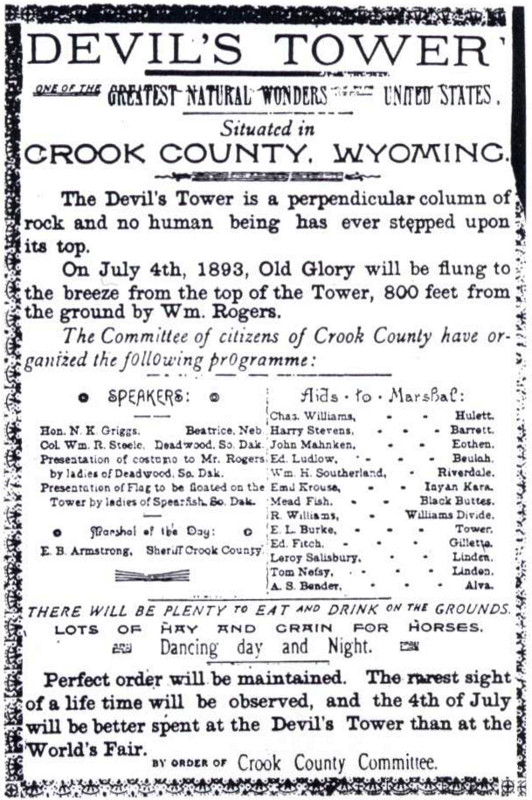
The handbill for the first ascent, on July 4, 1893, touted the event as better than the World’s Fair.
DEVIL’S TOWER
ONE OF THE GREATEST NATURAL WONDERS of the UNITED STATES
Situated in
CROOK COUNTY, WYOMING.
The Devil’s Tower is a perpendicular column of rock and no human being has ever stepped on its top.
On July 4th, 1893, Old Glory will be hung to the breeze from the top of the Tower, 800 feet from the ground by Wm. Rogers.
The committee and citizens of Crook County have organized the July 4th programme.
SPEAKERS:
Hon. N. K. Griggs. Beatrice, Neb.
Col. Wm. R. Steele. Deadwood, So. Dak.
Presentation of costume to Mr. Rogers by ladies of Deadwood, So. Dak.
Presentation of Flag to be floated on the Tower by ladies of Spearfish, So. Dak.
Marshal of the Day:
E. B. Armstrong. Sheriff, Crook County
Aids to Marshal:
Chas. Williams, Hulett.
Harry Stevens, Barrett.
John Mahnken, Eothen.
Ed. Ludlow, Beulah.
Wm. H. Southerland, Riverdale.
Emd Krouse, Inyan Kara.
Mead Fish, Black Buttes.
R. Williams, Williams Divide.
E. L. Burke, Tower.
Ed. Fitch, Gillette.
Leroy Salisbury, Linden.
Tom Nefsy, Linden.
A. S. Bender, Alva.
THERE WILL BE PLENTY TO EAT AND DRINK ON THE GROUNDS.
LOTS OF HAY AND GRAIN FOR HORSES.
Dancing day and night.
Perfect order will be maintained. The rarest sight of a life time will be observed, and the 4th of July will be better spent at the Devil’s Tower than at the World’s Fair.
BY ORDER OF Crook County Committee.
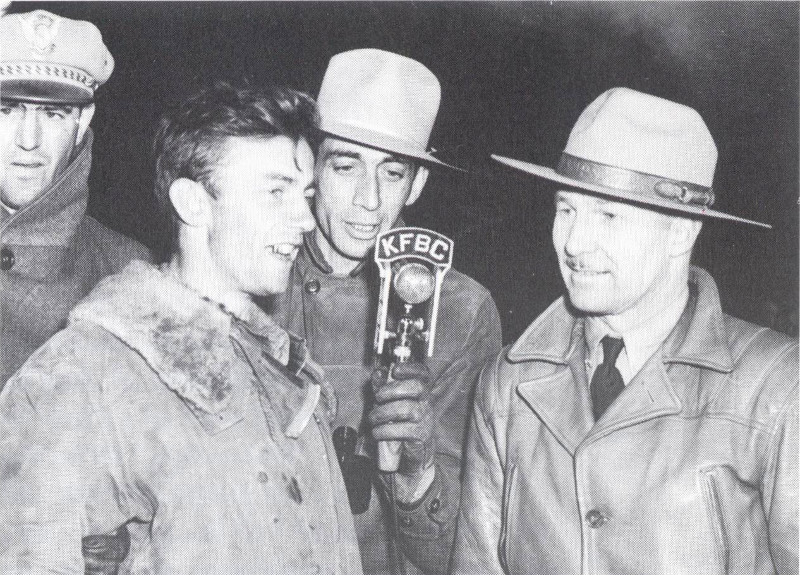
Parachutist George Hopkins, top second from left, and Superintendent Newell F. Joyner are interviewed by a Denver radio announcer on October 6, 1941, after Hopkins was rescued from the top, where he had spent six days.
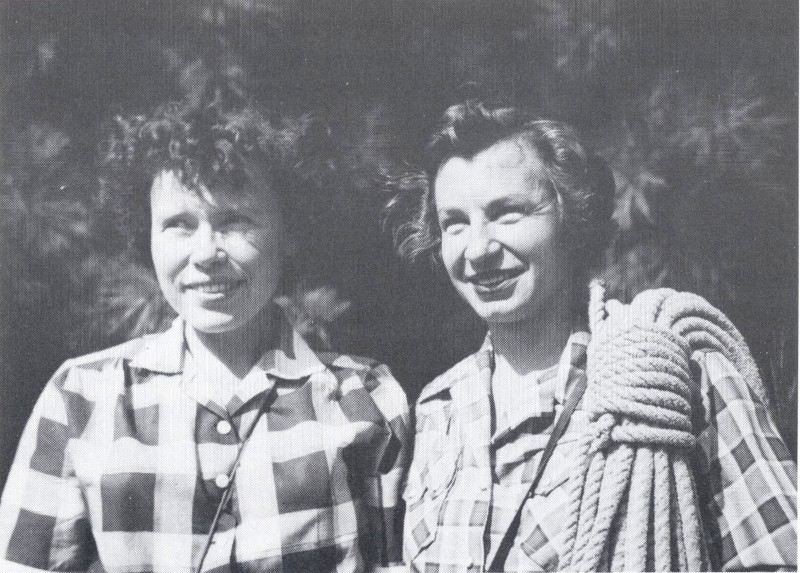
Jan Conn and Joan Showacre were members of the first all-woman party to climb the Tower, in 1952. Fritz Wiessner in 1937 and Jack Durrance in 1938 pioneered two of the first technical climbing routes. In 1948 Jan Conn climbed to the top with her husband, Herb.
When they reached the top, Rogers and Ripley strung up Old Glory from a flagpole they had somehow already managed to carry to the top! It was a spectacle in which many in the crowd below could claim a part. Muslin for the oversized flag apparently was purchased in Sundance, Wyoming, where it was painted and sewn together by a committee of boosters. Someone, it is said, had tailored a patriotic climbing suit of red, white, and blue that was presented to Rogers at ceremonies before the climb.
Ranchers who witnessed the event said that while Rogers may indeed have risked his neck on the Tower, he reaped an entrepreneurial bonanza afterwards. During the daylong merriment and the dancing that evening, his wife and his partner’s wife ran the only refreshment stand. The flag, which had blown down, was cut up and sold for souvenirs, and the ladies made a small fortune. Perhaps the boast of the handbill published that year by the Crook County Commissioners was true: It was possible to have a better time at Devils Tower that summer than in Chicago at the World’s Fair.
Rogers and Ripley raised a public spectacle perhaps not equalled until the caper of “Devils Tower George” Hopkins, the subject of a 1941 Tower-top rescue mission by alpinist Jack Durrance. Hopkins parachuted to the top and was stranded, keeping millions of newspaper readers in suspense over his fate atop the isolated rock monument few had ever seen. Durrance rescued his man five days later. Devils Tower again loomed in the national imagination, with the screening of the film “Close Encounters of the Third Kind.” And in 1979 a televised sports show featured George Willig, the “human fly,” whose climbing antics were beamed nationwide via space satellite. As we entered the decade of the 1980s the number of registered climbs of Devils Tower surpassed the 10,000 mark. But that’s jumping ahead too quickly in the chronology of this story.
At the turn of the century, the Tower became a natural meeting place for people who might see each other but once a summer at a Fourth of July celebration. Oldtimers recall that a small, rough-cut 17 wooden platform served as a dance floor; the merry-go-round had seats for four children at most; and the home-grown orator read the Declaration of Independence. The affairs were fun and lasted for days. People camped at the Tower, and sometimes those who came across the river from the east were stranded by a quick summer flood.
In time, the harshness of the frontier softened a bit. Towns and cities replaced crude settlements and provided secure bases from which to look out at the wonders of the land. The newly arrived settlers made the West their own. And, to compress time and events into a few words, some people began to think about protecting some of the uniqueness of the West.
The National Park System owes its existence to this dawning of a conservation ethic in the late 19th century. Yellowstone, in northwestern Wyoming, became the first national park in 1872. A few other tracts were set aside as parks in subsequent years, but the preservation movement surged in 1906, when Congress passed the Antiquities Act. The President now had the authority to create national monuments. Not only scenery was to remain unspoiled in these monuments, but also priceless Indian ruins, pottery, and projectiles and other objects of antiquity were to be protected from looting collectors. President Theodore Roosevelt made conservation a national goal and used the Antiquities Act to proclaim the first eighteen national monuments. Devils Tower National Monument became the first, created on September 24, 1906, giving Wyoming both the first national park and the first national monument.
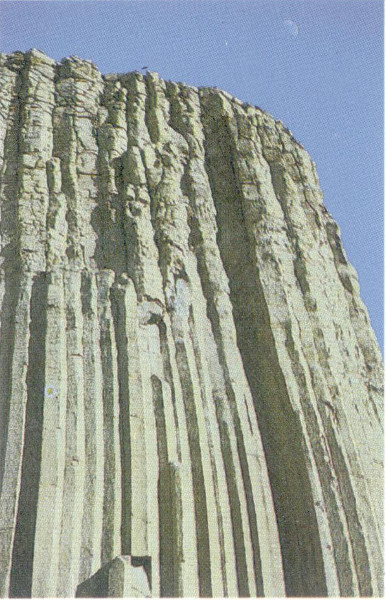
Light and shadows constantly play upon the Tower’s splintered, many-sided columns.
The next campaign was for money to build a bridge over the Belle Fourche River. By 1916, when the local families gathered at the Tower for another July Fourth picnic, it seemed that Congress would never appropriate money to turn the place into a proper public resort. A petition to Wyoming’s Congressman Frank W. Mondell complaining about washed out trails and difficult access to the Tower was circulated among the 1916 picnickers and may have done some good. The next year, the newly created National Park Service directed the building of an entrance road, soon to be improved again for auto traffic. By the end of the 1920s Wyoming’s participation in the national enthusiasm for highway construction was showing results. Old pathways followed by the Sioux, later broadened for buckboard wagon and stagecoach, were now graded and oiled for motorcars. A trip to the West was no longer an expedition of months: cross-country motoring had arrived.
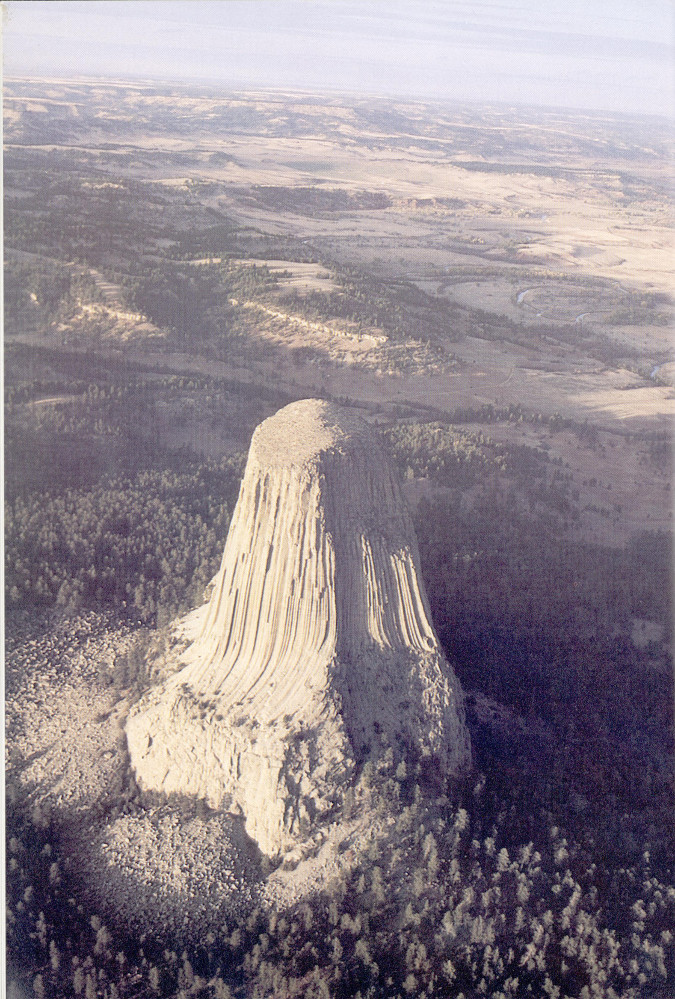
An aerial view discloses the tear-drop shape of the top and the extent of the Great Plains around the Tower.
Through the Depression years from 1931 to 1941 the number of tourists, vacationers, and sightseers tripled at Devils Tower. And in the meantime, an army of unemployed laborers and artisans, organized as the Civilian Conservation Corps, applied themselves to public works projects throughout the country. At last the park received the attention its admirers said it deserved. CCC workers built new roads over an access bridge only a few years old. Overnight campgrounds were landscaped and picnic areas were provided with tables and benches. Formal walking trails were made for orderly hiking excursions around the base of the Tower. Water and electrical systems were installed, and in 1935 a museum was built out of rough-hewn logs. The museum, filled with exhibits, still stands at the foot of Tower Trail and serves as a summer visitor center, book sales outlet, and registration office for climbers.
Ask the average traveler to Devils Tower for his or her impressions and invariably two things come to mind, or, more properly, stand tall. One is the immutable, immobile Tower; the other is the animated, lively prairie dog. The national monument has become one of several reserves for this beleaguered plains inhabitant, whose communal lifestyle is profiled in Part 2 of this handbook. Like the Tower, it is misnamed, but so fixed is it in our minds and experience that it will likely always remain so. Subjected to eradication campaigns throughout the plains area because of conflicts with livestock enterprises, these otherwise personable rodents are protected here at Devils Tower National Monument.
The visitor conveniences that were so long in coming to Devils Tower are now enjoyed by nearly 300,000 persons every year. They come for mid-June’s display of wildflowers, or mid-September’s fall colors. They come to challenge themselves in the tradition of William Rogers and Willard Ripley. They come to watch the prairie dogs bustle about in near-parody of our own busyness. But most of all the Tower inspires a swing-by on the way east or west, prompting some travelers to tarry for a day or two on this pleasant plainsland.
By Greg Beaumont
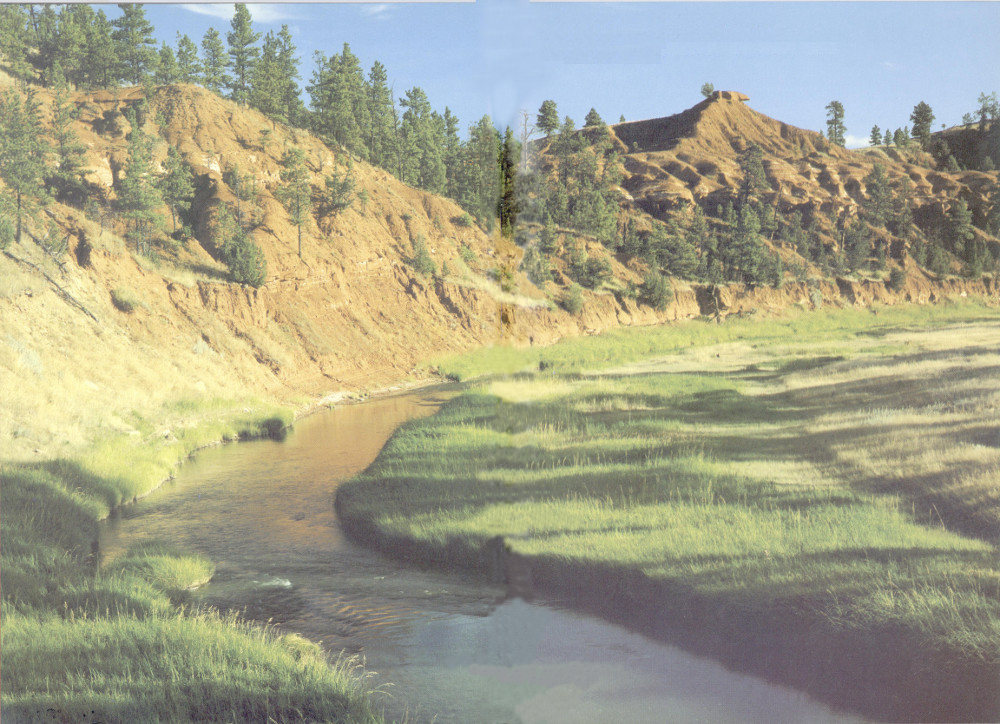
The Belle Fourche River meanders through northeastern Wyoming, exposing red banks of clay. It crosses the southeastern corner of Devils Tower National Monument near the entrance road.
Pouring a mug of boiled coffee, I wait for the sun to make its appearance. The cup steams in the damp, cool morning air. Shivering, I press both hands to the heat the thick porcelain holds.
The sky begins to purple, and stars dim perceptibly. Through the campground cottonwoods, the immense, shadow-black bulk of the Tower materializes against the sky. It is possible now to discern the flight of bats overhead. But, in an instant, their swirling, night-long ballet vanishes with the darkness.
From my campsite along the Belle Fourche—this narrow, meandering river the French fur trappers named “the beautiful branch”—I listen to the first sounds of the day. Across the river a great horned owl protests the morning’s swift advance. Coming through the veil of river fog, its haunting, pervasive hoo-hoo-hoooo is enough to freeze the blood of cottontails.
Even before the first hint of light, robins had begun to sing softly. In these unhurried morning songs they prove themselves thrushes. With the increasing light, the growing blend of wren, vireo, and thrasher music intensifies. These soft phrasings soon quicken into proclamations of territory, and meadowlarks, mourning doves, and yellowthroats compete across thicket, river, and meadow, their singing seemingly sharpened for distance and authority.
Nearby, a cottontail grazes on the dew-bent grass. It pauses occasionally, pointing its ears and working its nostrils in my direction. Three whitetail deer continue their cautious single-file approach, heading from the river bottom toward the higher ground of the prairie dog town. Crossing the campground, they repeatedly stop to inspect their surroundings. A log snaps and whistles in my fire, bringing their heads about in immediate, almost mechanical unison. Deliberately the lead animal lifts its tail to expose its white, silent signal of danger, and all three step smartly away as if in time to a fast metronome.
Direct sunlight spotlights the Tower. As though to challenge the sudden appearance of a gigantic, equally yellow competitor, a meadowlark takes wing, singing its loud, clear claim over the prairie dog town. Dawn is announced, the day begun.
The level rays of the sun accentuate the Tower’s vertical polygonal columns. The stark contrast of light and shadow imparted by the graceful taperings 25 of the soaring, many-sided columns give the Tower a man-made look. In this light it resembles the ruin of a stupendous ancient temple, not the casual result of some remote geological event.
Sipping the strong coffee, I wonder at the long procession of vanished Indian societies that camped and hunted here periodically through the centuries. These ancient peoples devised various stories to explain such an unusual landmark. And yet what science now says about the creation of Devils Tower would have seemed to those tribes as fantastic as their legends of a gargantuan bear gouging the rock seem to us today. Minor uncertainties remain, but geologists have pieced together a rough picture of the Tower’s probable origin. Some 60 million years ago, great Earth stresses began to deform the crust of the continent, resulting in the uplifting of the Rocky Mountains and Great Plains region. As the surface rock layers began to crumple and fault, magma from deep inside the Earth welled up into many of the resulting gaps and fissures. In many places on the continent, spectacular volcanoes formed, erupting with explosive force.
As the Rockies were being created, the climate of the continent’s interior began to change. The long reign of the dinosaurs that had presided over a stable, tropical landscape was coming to an end. The climate was gradually becoming cooler and drier. Doubtless the immense volumes of volcanic ash ejected into the atmosphere prevented a percentage of solar heat from reaching the Earth. Certainly the rise of the Rocky Mountains to the west influenced the old weather patterns. As the mountain blocks rose higher, they intercepted the warm, moist winds that blew inland from the Pacific. With the air masses rising ever higher, more and more of the moisture that had watered the extensive inland Cretaceous forests and swamplands was prevented from reaching what we know today as the Great Plains.
Steadily the forests retreated eastward as the “rain shadow” cast by the mountains extended eastward, shutting off the moist, warm Pacific winds. No longer moderated by these winds, the mid-continent was increasingly opened to seasonal invasions of northern arctic air. Newer ecosystems, such as deserts and grasslands, slowly evolved to replace the lush forests and swamps that had for so long sustained the dinosaurs. 26 Just as drought, fire, and temperature extremes began to alter the old order in the plant kingdom, so did the more adaptable mammals and birds begin to replace reptiles as dominant animal forms.

Both the Kiowa and Cheyenne Indians held similar legends on the origin of the Tower. The story goes that tribal members were surprised by a gigantic bear, and their incantations caused a low, flat rock to rise, lifting them above the reach of the bear. The massive beast then gouged huge vertical marks into the rock as it attempted to reach the people. Finally, the Indians were able to kill the bear.
But not all the magma that welled upward during this restless period reached the Earth’s surface. Extensive masses were trapped far below the surface, where they gradually cooled and congealed. The Missouri Buttes and Devils Tower, however, are believed to be necks of extinct volcanoes. Geologic evidence indicates the Missouri Buttes formed first in two separate eruptions. The magma hardened, plugging the plumbing underneath. A third eruption to the southeast resulted in Devils Tower.
During the ensuing tens of millions of years, the gradual erosion of the overlying rock strata revealed these intruded plugs of volcanic rock. Since this dense, hard igneous rock resists erosion much better than the surrounding sedimentary rock, these formations will continue to stand out as features.
That ancient land of sedimentary rock through which the molten mass of Devils Tower penetrated may at one time have been as high as the golden eagle I now see drifting high above the Tower. Circling slowly in its morning hunt, the eagle spirals upward on the currents of warm air rising off the sun-heated rock. Perhaps it now soars at the elevation of the land long ago when the heavy, ringing-hard rock of Devils Tower oozed like paste far below the surface.
Today the top of the Tower is 386 meters (1,267 feet) above the Belle Fourche River. If that warm, Cretaceous landscape rested 600 meters (2,000 feet) above the present summit of the Tower, then more than 900 vertical meters (3,000 feet) of sedimentary rock has been pared away in the last 60 million years.
The relentless physical agents of erosion—running water, wind, and frost action—together with chemical breakdown of rock particles, continue to alter the landform. Given enough time, even the very hard rock of the Tower itself will waste away.
Sixty million years ago, when dinosaurs Triceratops and Tyrannosaurus Rex duelled beside the lush river banks of the predecessor of the Belle Fourche, the ancestor of the golden eagle was flying overhead. Millions of years hence, a descendant of the eagle might soar above this same Wyoming landscape. Missing will be the unique shaft of fluted rock we call Devils Tower. And what of the men, who for a mere eyeblink of time, hunted in its shadow or came to wonder at its somber countenance in the morning sun?
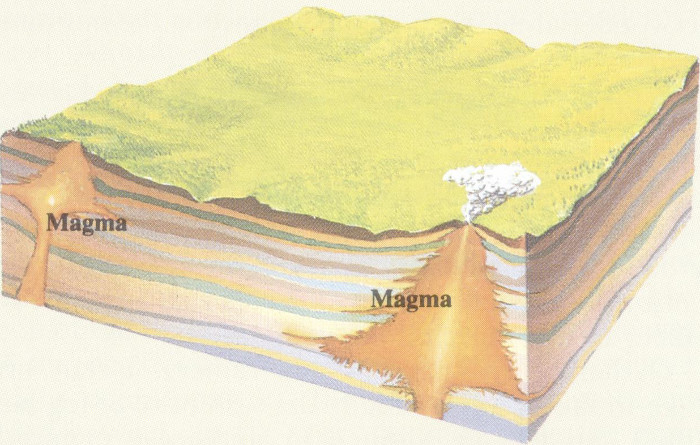
About 60 million years ago, in early Tertiary times, a mass of molten magma forced its way upward through the relatively level layers of red, yellow, green, and gray Jurassic sedimentary rocks that make up northeastern Wyoming. The mass cooled into a hard, igneous rock called phonolite porphyry. An earlier flow of magma occurred about 6.5 kilometers (4 miles) to the northwest.
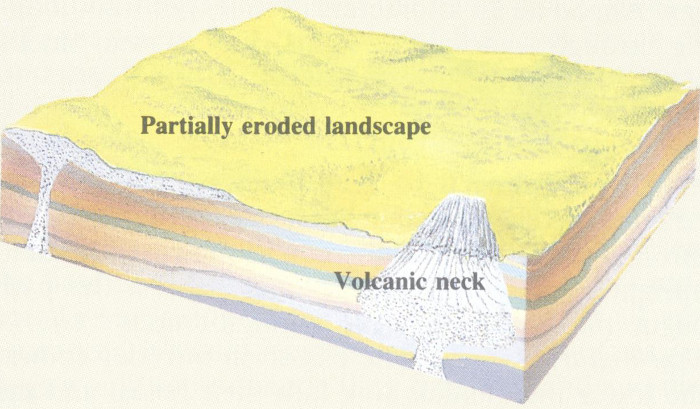
As millions of years went by, the soft sedimentary rocks were eroded, exposing what eventually became known as Devils Tower and the Little Missouri Buttes. The erosion process continued, baring more and more of the dense, gray rock. Apparently, as the magma cooled, the rock contracted and fractured into columns of 4, 5, 6, or more sides. The larger columns are 2.5 meters (8 feet) in diameter at their base and taper to about 1.2 meters (4 feet) at the top.
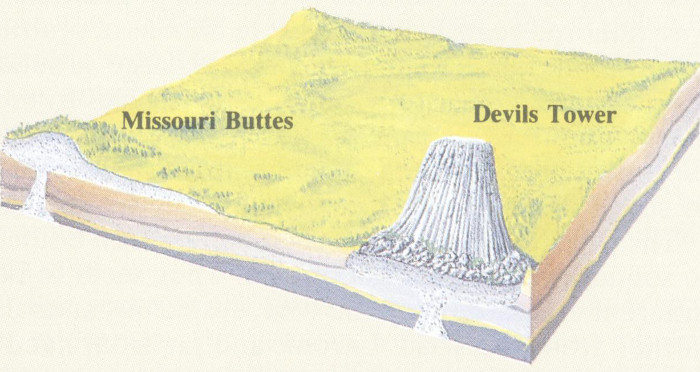
Today the Tower rises 264 meters (867 feet) from its base to an elevation of 1,560 meters (5,117 feet). The top is 386 meters (1,267 feet) above the Belle Fourche River at the entrance road. The tear-drop shaped top measures 91 meters (300 feet) from north to south and 55 meters (180 feet) from west to east. The sides rise almost vertically from the base for 12 to 30 meters (40 to 100 feet) to a narrow bench, from which they again rise steeply to the summit.
A thwack of an ax against wood puts an end to my daydreaming. My companion the cottontail hops for cover. The pair of magpies that have been feeding on the remains of a road-killed ground squirrel flash upward to safety. The gradual awakening of campground life inspires woodpeckers to hammer in the cottonwoods, and a yellow-breasted chat adds its odd jibber to the collected noise.
Gathering up knapsack and camera. I start my hike to the Tower. Already the sash of river fog has lifted and the air warmed to shirtsleeve comfort. From somewhere on the red cliffs that gown the Tower’s base, the faint singing of a rock wren beckons. Ahead lie 13 kilometers (8 miles) of trail, looping through a mosaic of sights, sounds, and smells of grassland, pine forest, woodland, and river.
Leaving the campground, I follow the trail that leads through the prairie dog town. The prairie dogs stand upright as I approach. The ones nearest the path begin their warning call, a monotonous “churk-churk-churk-churk.” The closer an intruder comes, the lower the animals sink into their holes, and the faster and shriller the chant becomes. Finally, with a last flick of its nervously twitching tail, each disappears into the safety of its burrow.
Prairie dogs, like the bison that once shared their vast range, are now reduced to remnant populations. Two hundred years ago, there were billions of prairie dogs on the shortgrass plains; these large ground squirrels had successfully adapted themselves to the harsh conditions. Perfect digging machines, they escape most predators and the extremes of the weather by spending more than half their lives underground.
The prairie dogs near the road do not even bother to sound a warning as I approach. They seem to be different creatures from the wild, suspicious animals farther from the road. Laconic and fat from handouts, more curious than cautious, they approach rather than retreat. These animals are easier targets for the redtail hawk that is screaming above the river 29 timber, or the golden eagle that sails high overhead.
Across the road, the trail leaves the grassland of the prairie dogs and climbs steeply among ponderosa pines. Already the sun grows hot. At the edge of the forest, I stop to rest and survey the landscape before me. Spread out below, and now shimmering with sundance heat, the buff-colored dog town stands out in stark contrast with its darker, greener surroundings.
Although I sit only 30 meters (100 feet) or so above the dog town, I am struck by what my vantage point reveals: a clear patchwork of life communities. The loop of the Belle Fourche and the June-bright leaves of the deciduous trees lining its course provide a bright counterpart to the somber, pine-scattered ridge beyond. Just a short distance away the ponderosas appear more black than green. It was just such a quality that gave the distant, pine-covered mountain range to the east the name Black Hills.
From where I sit, the lobe of the level bench of land that juts into the river looks as if it were graded and maintained by man, for its close-cropped vegetation contrasts greatly with the rugged ridge beyond. But this old floodplain was graded level by the river, and prairie dogs, not machines, clip the vegetation.
This small area of grassland, sandwiched between the base of the Tower and the encircling river, supports a surprising amount of life. Yet from all appearances, it would seem as if the multitude of prairie dogs would soon denude their patch of land and die of starvation. In contrast to the surrounding territory, the vegetation of the dog town appears exhausted.
Indeed, today’s empty plains give few hints of what a crowded stage the shortgrass plains once was. Before the coming of the white man, the grasslands teemed with bison, pronghorn, wapiti—named buffalo, antelope, and elk respectively by European settlers—and sprawling towns of prairie dogs. Astounded early observers, accustomed to the lush flora of the eastern woodlands, could not imagine how so many animals could survive in such a parched-looking land.
The secret is the grass itself. Whether tinder dry in midsummer or dead in winter, the grass blades remain highly nutritious. Grass plants can withstand repeated grazing and fires since new growth progresses from the stem joints rather than from the tips.
continues on page 32

Photographer Galen Rowell and writer Dennis Hanson decided to climb the Tower in October 1978 to find out for themselves what’s up there. After a strenuous five-hour climb, interrupted by occasional clouds of rock doves (below), they reached the top and found the surface is not as flat as it appears from down below or even from an airplane. Besides grasses, they found sagebrush, currant, and prickly pear cactus (below). As they were cooking dinner, a wood rat (below) joined them, nibbling at their food packets, peering into a pot, and nosing about their climbing gear. They also saw chipmunks and plenty of birds (See pages 44-45, 60-61), but, perhaps because of the coolness of October, they did not see any rattlesnakes, which others have found there sometimes. How did the animals get to the top? Some people have speculated that they were dropped by predatory birds, but that is questionable: they probably would have been killed by the birds’ talons or by the plunge to the surface. More than likely they just climbed up the Tower’s sides and took up residence. Many climbers, of the human sort, have reported seeing snakes and rodents working their way up fissures.
31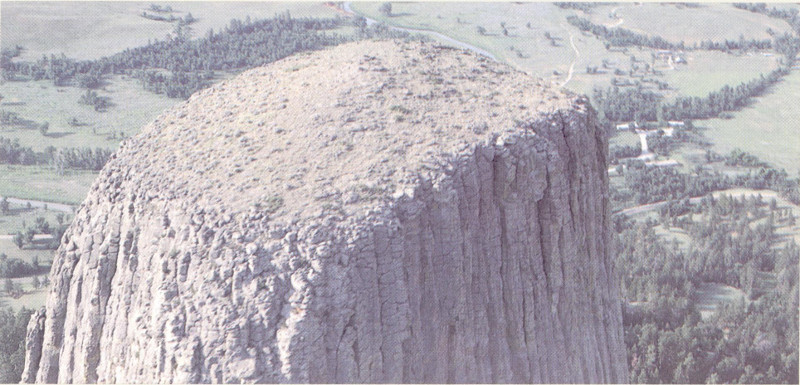
What’s on top of the Tower? Most climbers report that the summit is similar to the surrounding landscape. Grasses cover much of the rocky surface, but better than that, a few snakes and mammals live there!
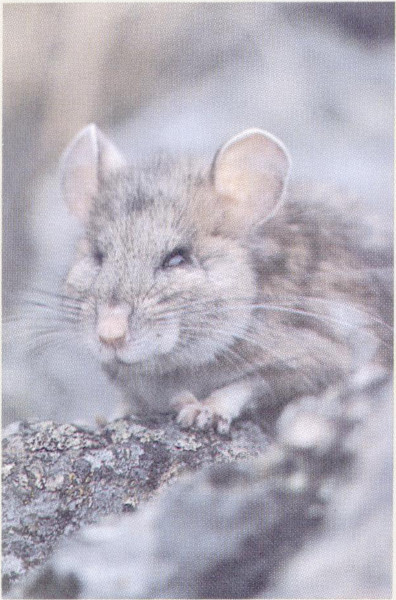
Wood rat.
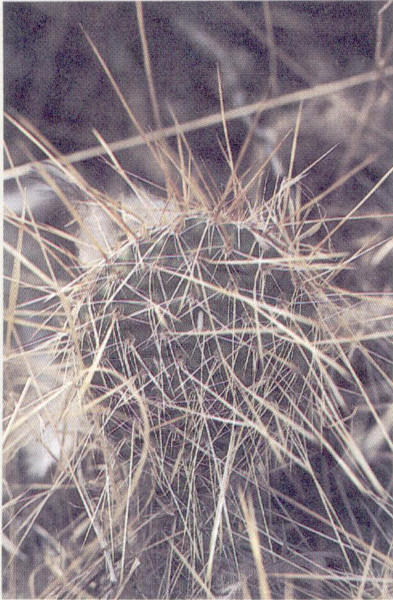
Prickly pear cactus.
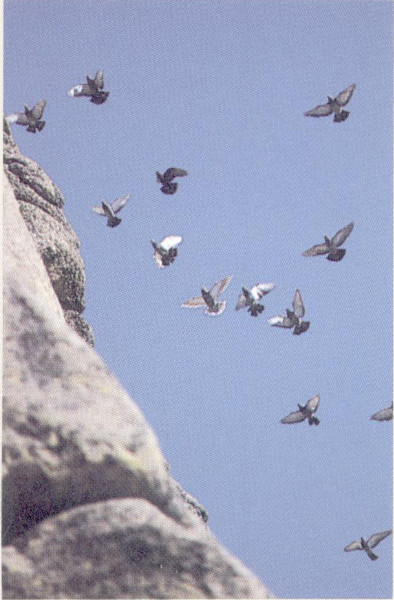
Rock doves.
In addition, most plains animals contend with the semi-arid conditions of their environment by making efficient use of available moisture. Pronghorn, prairie dogs, and kangaroo rats, for example, need never take a drink since they obtain necessary water from the plants they eat. Such plant and animal adaptations explain why the shortgrass plains can sustain such a vast panorama of life.
From a tall pine upslope, a red squirrel chatters with indignation at discovering my intrusion into its domain. The bell-like song of a rock wren answers from an outcrop nearby. The small gray bird appears atop a boulder, motionless but for an instant, then hops down to resume its search for insects among the bright, arid cliffs it claims for its own.
I realize that I am seeing more than scenery here. All around me are boundaries—conspicuous where defined by plants, but invisible where respected by animals. No prairie dog has ever traveled across this slope, and no red squirrel has ever scurried into the treeless expanse of the prairie dog town. On no occasion would a rock wren enter the deep pine forest. Should its food supply somehow vanish, it would perish among the bare earth and gully washes of its own habitat rather than hunt the dog town or forest floor.
Each animal species is adapted to the conditions of its preferred environment. The prairie dog and red squirrel have similar roles in their respective habitats, as do the meadowlark in the grassland, the house wren in the deciduous woodlands, the rock wren on barren slopes, and the brilliant western tanager of the pine forests that is calling “pit-ik, pit-ik, pit-ik” from a branch overhead.
Whether herbivore, carnivore, scavenger, or decomposer, all of the countless, magnificently varied life-forms of each community share in the endless flow of chemical energy that originates with the touch of sun on chlorophyll. Eagle, prairie dog, bacterium, man—we all owe our lives, directly or indirectly, to the green leaf’s unique ability to convert light energy into chemical energy.
So does this colony of black ants foraging near my feet. Back and forth the living lines run, each individual obeying its ancient, perfected legacy of instinct. One carries aloft the bright green corpse of a lacewing. With a little last-minute help from fellow 33 workers, the ant carries its burden down into the nest hole. With its powerful jaws, another ant tugs the brittle remains of a once formidable foe—a jumping spider. So intent is the ant in its labor, it fails to avoid a deadly trap, however. In the soft ground along the margins of the trail is a craterfield of funnel-shaped pits. At the bottom of each, hidden just below the soil, waits quick death in the form of jaws even stronger than the ant’s. These insects, called antlions, are the larval stages of the equally voracious tiger-beetle.
Having tipped its load over the rim of the funnel, the ant disengages itself and attempts to crawl up the incline and get to the other side of the spider to pull it out again. But the loose soil particles offer little traction and the ant begins to slip. Frantic, it works its legs faster, making it slide downward more quickly. Alerted now by vibrations from the struggling insect, a hidden antlion waits its moment to strike. When the ant touches bottom, the hooked jaws appear, snapping once, twice, and finally closing shut about the thorax of its prey.
In a moment, all is over, the ant dragged beneath the soil at the bottom of the crater. The corpse of the spider, part way down the incline, is occasionally investigated by other passing ants. But the ants at the lip of the trap seem to sense the danger and leave the stranded prize alone. Other antlions, at the bottom of their expertly engineered traps, lie hidden from the passing parade of life above. Obeying their own instinct messages, they need only wait to survive.
A disturbance in the dog town starts the animals to barking and scurrying in every direction toward their burrows. Two figures from the campground have appeared up the incline. Their determined stride and the coils of rope at their shoulders suggest that the Tower’s summit may well be explored again today.
Already tall cumulus clouds, the beginnings of thunderheads, are building along the eastern horizon. A gust of hot air from the sun-baked ground below rushes into the pines, making the branches whizz into motion. A pine cone bounds against rock, setting the red squirrel to chattering again. I head for the Tower Trail, leaving behind the ant colony’s ordered turbulence and the view of the deserted dog town dancing in the sun.
At the juncture with the Red Beds Trail, I decide to follow the longer circuit of the Tower. The higher, shorter Tower Trail, which bracelets the rock-strewn base, can be picked up at the Visitor Center, where this trail ends. Folding the map, I hear the climbers approach.
“Good morning.”
The girl’s smile does not soften the concentrated expression all climbers wear before ascent.
“Which way are you going?” I ask, trying to conceal my lack of knowledge about any of the routes and knowing full well I would never venture what they are about to do.
“Left arm of the south face this time,” says the man. He obviously does not desire the delay of conversation but does volunteer that he had made several climbs the summer he worked here.
I hold them with another question: is there anything interesting on top?
“Terrific view. Grass on the summit; lots of chipmunks; once a rattlesnake was sighted. Well, we better get moving.”
“Good luck,” I call after them. The expression seems a lame wish for rock climbers. Soon they are brightly clad specks weaving through the trees. Looking up at the summit that towers above them, I wonder how a chipmunk or snake could have possibly gotten there—perhaps only by escaping the talons of an eagle or hawk. But could that happen?
More than 1,000 ascents of Devils Tower are now made each year. The almost casual manner in which experienced climbers regard the structure—often scaling it to keep in shape for “difficult” climbs—would have astounded early explorers, who regarded it as unscalable.
Shrill, rapid cries of a prairie falcon echo from the Tower wall. Although hidden from my view by the pines, its circling flight is revealed by its bursts of screams. It scolds the climbers who are now pressing upward and perhaps invading the security of its nest site. But the commotion soon dies away, indicating that the sharp-eyed falcon is more annoyed than threatened. Should the climbers inadvertently come close to the nest, however, the protective bird would repeatedly dive at the intruders in an attempt to drive them away, a distraction I would not relish.
I continue down the trail, which gradually drops toward the river. The pines yield to communities of deciduous vegetation interspersed with grassy meadows. A whitetail deer stands at the far edge of the narrow meadow the trail is about to enter. Not yet aware of my presence, it continues to browse the succulent new growth of a chokecherry.
Were it not for the meadows and wooded ravines that surround the higher reaches of the pine forest, the Monument could not support as many deer as it does. Deer like a mix of woodland and meadow. The dense cover of shrub thickets, canopied by closely spaced elm, chokecherry, hawthorn, and other trees, offers sanctuary and browse. The nearby meadows provide essential diet supplements of grasses and herbs.
As I move on, the deer dashes away. A cottontail bounds across the trail and overhead, on a long, twisted branch of a burr oak, a fox squirrel scurries upward to safety. A brown thrasher scolds momentarily but soon resumes its complex song. Its music is as various in shading and structure as the many leaf shapes that can be discovered in its habitat.
Before abruptly reversing itself, the trail makes a long swing northward. Leaving the pines, it crosses the maroon sediments that give the Red Beds Trail its name. The exposed formation has been cut into steep cliffs by the river. Deposited some 180 million years ago during the Jurassic Period, when the land surface was low and adjacent to a sea, this mixture of siltstone and sandstone is poorly cemented together. As a result, it weathers easily, forming a striking, ravine-cut outcrop wherever the stratum is exposed. Few plants colonize this handsome formation, making it stand out against the dull, igneous-gray Tower and its dark wreath of ponderosa.
As the sun approaches zenith, I am nearing the end of the trail circuit. Coming back closer to the Tower, the trail re-enters the pine forest. I welcome the perceptibly cooler air and dimmer surroundings beneath these big, yellow-barked trees. Here, where lichen and moss cap boulders and fallen logs, is a good spot for lunch. I sit with my back to the trunk of an ancient, fallen giant whose length has collapsed and defines the contours of the ground. Its exposed, rotten heartwood nourishes miniature fungi-gardens.
Compared to the sharp shadows and glare of the 36 meadows and thickets I have left behind, the evenly shaded pine forest seems serene. Except for a diminutive red-breasted nuthatch that patrols up and down a nearby tree trunk, gleaning grubs and other insects as it goes, there is no perceptible motion. Even the few shafts of sunlight that touch the forest floor here seem, like me, to be intruders. Sound itself seems unwelcome. No birds sing or squabble or dart their colors to catch the eye. If anything walks or hops about, no leaves rustle to reveal its presence. Years of needle-cast shroud the uneven ground, giving the dissimilar shapes of rock and downed trees a sameness of color and texture.
Comparatively few life-forms inhabit the pine forest. Fewer kinds of plants grow beneath the pines than grow in the deciduous woodland. And fewer plant types mean a more limited diet for herbivores such as insects, mice, cottontails, and deer. The scarcity of insects also reduces the number of bird species that will find the habitat attractive.
The relative absence of life on the forest floor begins in the soil. Pines create acid soil conditions which do not promote bacterial growth. Decay, therefore, carried on primarily by fungi, takes place very slowly. The result is the thick accumulation of discarded needles and branches, the resinous, sweet-smelling “duff.”
Not far upslope from the trail a porcupine scuttles toward a stand of young pines. It moves slowly and silently, its quills making it look prehistoric. Again I am struck by the apparent changelessness of the pine forest.
But looking around, I find everywhere signs that indicate change and struggle. At the bases of the giant pines—some of which may be more than 200 years old—are fire scars. Most of the mature trees survived the frequent fires that once raced through here. Their bark was thick and fire-resistant, and they had few lower branches to pass the flames up into the vulnerable upper branches. But that was before the white man interrupted the long reign of wildfire. Ironically, fire had actually helped to maintain the health of the forest. Grass fires, sweeping into the pines, burned off the accumulations of litter and killed many of the crowded younger trees. Tinder was thus removed before it could build to dangerous levels.
continues on page 40
Some animals indigenous to the Great Plains find a protected home in Devils Tower National Monument. Gone from this area are the bison that once roamed the prairie grasslands in great numbers, and the fastest plains animal, the pronghorn antelope, is rare. The most noticeable mammals here are the whitetail deer and the prairie dog (See pages 48-65 for pictures and text about the prairie dog and its predators), but with careful observation you can spot some of the smaller animals that inhabit the grasslands, woodlands, and rocky areas around the Tower.

The raccoon, primarily a nocturnal creature, prefers woody or swampy areas and often dens in hollow trees.
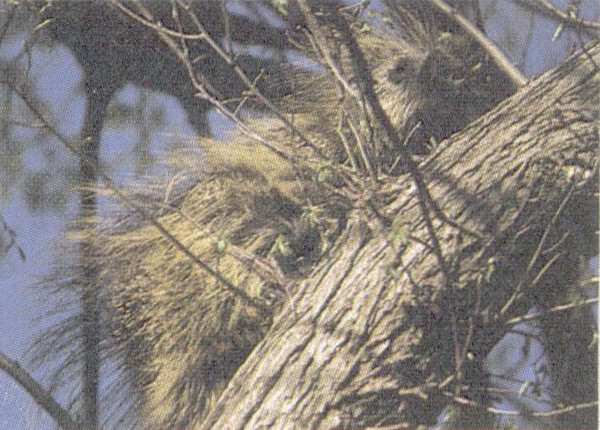
The porcupine, which has up to 30,000 quills, dwells in the forest and often is seen in the tops of trees.
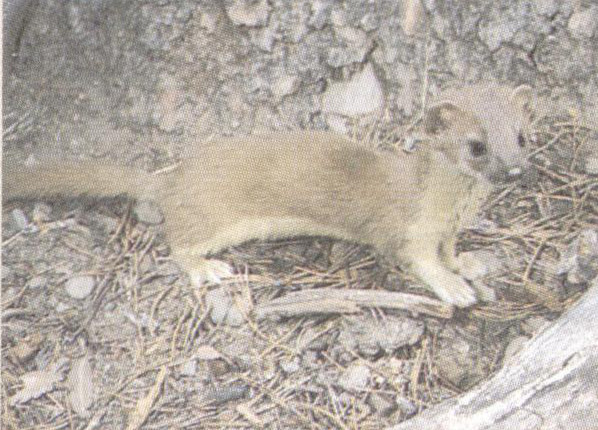
The longtail weasel usually lives in deserted burrows and preys on small mammals, some birds, and other animals.
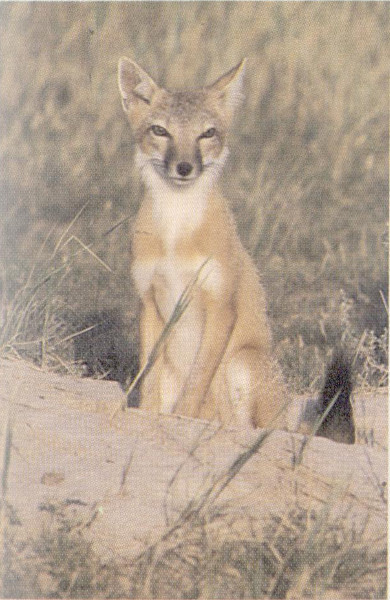
The rare swift fox sometimes enlarges and inhabits an old prairie dog burrow. The red fox is more common here.
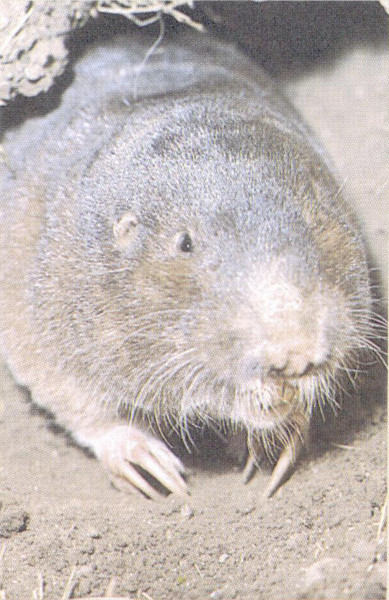
The pocket gopher is a remarkable burrower, creating up to 150 meters (500 feet) of tunnels close to the surface.
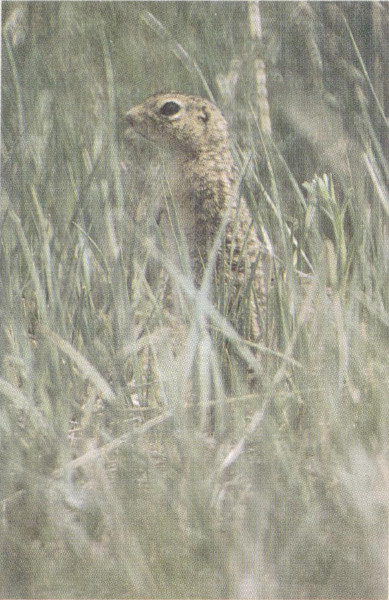
The thirteen-lined ground squirrel lives in a burrow in open areas, feeding mostly on seeds.
38
Whitetail deer mostly inhabit wooded areas in the park, though you may see them in clearings. Often they wander into the campground near the Belle Fourche River at dawn and dusk, providing an added treat to those who spend a night or two in the park. Deer usually do not go beyond an area of 4 square kilometers (1.5 square miles) even when their food sources are limited. They are browsers, eating all foliage they can reach standing on their hind legs. So, you may notice most foliage denuded to a 1-meter (3-foot) level, especially where their populations are high.
Whitetail deer can run 56 kilometers (35 miles) per hour, jump 2.7 meters (8.5 feet) high, and leap about 9 meters (30 feet), all quite gracefully.
Now, after 80 years of fire-prevention management, the forest is ripe for fire. Should it come now, however, the effects might be devastating. Fed by an abundance of ground fuel, a cool-burning, fast-moving grass fire could quickly become “hot.” Lifted up into the upper branches of the old pines via the closely spaced younger trees, the ground fire would quickly develop into a crown fire. Few, if any, trees would survive such a conflagration.
The role of natural fire has only recently been appreciated. However, in the small area of Devils Tower, where the scenic qualities of the pine forest are paramount to visitor enjoyment of the Monument, fire cannot be permitted without virtual destruction of the surrounding forest. Thus, for esthetic reasons, fire is regarded as unacceptable here.
After lunch I walk on beneath the trees. The openness of the mature pine forest soon gives way to dense groves of younger ponderosa. Deprived of the separation they require to develop naturally, these “doghair” stands strain upward together their trunks toothpick thin—to reach the light. Many exhibit long, yellow wounds, from which sap bleeds. This is the work of porcupines. Gnawing through the thin bark of young trees with sharp, chisel-shaped teeth, they strip away the tender, living tissue of the tree. Most wounds are not severe, but should the trunk be girdled, the moisture and nutrient transport system of the tree will be severed and the pine will die. Thus, even though fire no longer occurs here regularly, other agents of control, such as porcupine damage and insect infestation, continue to work.
The trail emerges from the deep north-slope forest, runs parallel to the visitor center access road for a short distance, and ends at the parking lot. The glare of afternoon light and shimmering heat waves is a sharp contrast to the cool, dim surroundings of the deeper forest.
Before continuing on around the circuit of Tower Trail, I stop at the visitor center for water. Beside the fountain sits an old man, leaning his chin and hands on a cane and staring upward at the broad west face of the Tower. An immense mushroom of a towering cumulus cloud billows up behind it.
“Quite a sight,” I say.
He seems to deliberate, then finally answers: “I can remember seeing a picture of this in my school 41 book. I never thought I would live to see it. Never thought I would ever sit here like this and see it genuine.”
I don’t know what to say. One does not make idle conversation with a man who has made a pilgrimage. We watch a pair of rock doves, outlined against the white brilliance of the boiling cloud, ride an updraft near the summit. Wings set and almost touching, they dip and recover, their resonant calls clear despite the distance. Nothing more to be said, I set out toward the trail. Not once did the man take his eyes off the Tower.
With the first dull report of thunder, I hear the chiding call of the falcon again. Its sharp voice momentarily silences the mellow cooings of rock doves that filter down from the high crannies and ledges.
The trail steeply ascends a slope of broken, fallen columns, weaving among the immense rock slabs like a mouse-run in a boulder field. I am surprised to see a grove of aspens. Their crooked trunks bend in the freshening wind, their leaves dancing and blinking on and off the dusty silver of their undersides. What a contrast to the rigid stature of the surrounding pines that barely acknowledge the approaching storm.
The presence of aspen probably means that a fire once swept across this dry western shoulder. Quick to invade new territory after a fire, aspens play an important role as a pioneer species of the western and northern American coniferous forests. Like the ponderosa, they can grow on dry, rocky sites. Since they often reproduce vegetatively—a grove of aspens is often produced by sprouting from the roots of a single tree—aspens are well suited to unstable or fire-swept sites. Although readily consumed by fire, aspen groves regenerate quickly from their undamaged root systems. Without periodic fire, in fact, aspens are eventually excluded from the forest composition, shaded out by the taller growing conifers.
The growing turbulence spurs me onward. Hugging the steep upper slopes of the Tower’s circular base, the trail allows a speedy orbit. The falcon continues to scream. Now along the southeastern face, I can hear the climbers shout to one another. The belly of the cloud is overhead and angry-black. Lightning flashes are now immediately followed by loud reports, sharp as splitting wood. I should turn back 42 and drop to the nearby trail that returns to the campground, but the swell of wind in the pines and the occasional crash of falling snags is invigorating. A sudden invasion of cold air means the rain will come heavy and soon. I wonder if the climbers are as unprepared for this as I am.
In a rock crevice where the trail passes along a cliff face, an untidy ring of trash reveals the nest site of a wood rat. Called “pack rats” because of their habit of carrying off unguarded items, these big rodents adorn their nest entrances with anything from bottle caps to sunglasses. This one has amassed a fine collection of discarded gum and candy wrappers. As the first large raindrops thud down into the trail’s soft earth, I envy the animal’s protective retreat.
In ten minutes I am back at the spur that leads to the Visitor Center. If the old man is still there, perhaps I will wait out the storm with him beneath the porch roof. But I cannot see him, so I continue on to the campground. I am already soaked through anyway, so the lashing rain is no longer a threat. I retrace the section of trail I had walked an hour before. Ten minutes more and I leave the pines and enter the deserted, puddled prairie dog town.
Nearing the road, I see a car approaching slowly. As it passes I notice the old man. Leaning forward, he cranes his neck to catch a last glimpse of the Tower he had waited so long to see.
By late afternoon the storm has passed, and with the return of sunlight a rainbow arches the Belle Fourche. Taking advantage of the softened earth, the prairie dogs busily reshape their mounds, scratching dirt loose, bulldozing it up the slopes of entrance mounds, and tamping it. All but the young wear black noses. At the return of the climbers the town suspends its work, rises to alert, and chirps warning.
A meadowlark sings from a fence post near the river. Against the purple southern sky, its black and yellow vestments seem unnaturally bright, and its call in the rain-cleared air seems sharply amplified. It glides into the glistening grass. Soon the female, wearing a duller version of its mate’s tuxedo, flies up and disappears across the narrow river. When she returns, her bill is crammed with insects for her demanding 43 young in their grass-lined ground nest.
A red-headed woodpecker, which has been shuttling between a certain cottonwood and other trees, also reveals its nest site. High up in the tree it has excavated a perfectly round hole. Leaning back on stiff tail feathers, it jerkily climbs up and around the trunk, pauses at the hole, then leans in to deliver the white grub to its squealing young.
So insatiable are nestling birds, their demands exert a significant control on insect populations. A pair of adult house wrens may log more than 1,100 daily trips to feed their young.
That so many varieties of birds can co-exist in the same area is possible because different species generally do not compete with one another for the same food source. Each gleans its food in a slightly different manner and locale. Each species vigorously defends its territory from others of its kind but will tolerate neighbors that occupy a different niche in the community. A single plum thicket may contain the nests of a pair of catbirds, mourning doves, robins, and vireos. Because each bird hunts its food in a slightly different manner and place, they do not directly compete.
The cliff-nesting swifts and swallows have reappeared above the river, a twittering confusion of swirling, darting shapes that manage to survive by capturing insects on the wing. Higher up, the booming of nighthawks announces that insects are active in the upper air also.
After supper I walk along the river. Now that shadows fill the river bed, there might be an opportunity to see a beaver working or a mink hunting along the shore. Passing close to where the meadowlarks have their nest, I cause a panic of concern. Both birds, invisible a second ago, lift off the ground, scolding and threatening, to distract my attention from the location of the nest. The outcry brings a killdeer up from the shore of the river. Uttering its plaintive, reedy cry, it circles about, lands, runs rapidly along the bank, then crouches down to display a “broken” wing. It is joined by a mate and both birds take up the act, leading me away from their own eggs or helpless young hiding motionless on the ground. So adept are the killdeer at this diversion, it seems incredible that instinct and not intelligence is responsible for their highly specialized behavior.
continues on page 46

Among those birds living in the forest at the base of the Tower is the white-breasted nuthatch, which commonly makes its fur- and bark-lined nest in the cavity of a tree. Many a woodland hiker has paused for several minutes to watch this inquisitive, sparrow-sized bird creep head first down the trunk of a tree, stopping now and then to look out at a 90 degree angle. The red-breasted nuthatch also inhabits the park.
45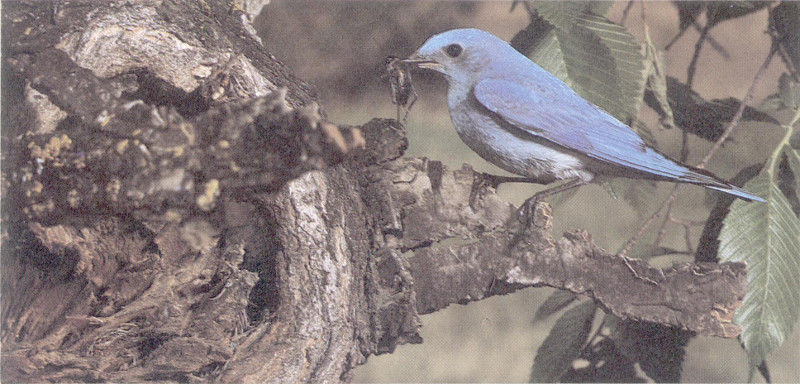
The intense sky-blue of the male mountain bluebird catches the eye of the most casual of birdwatchers. Its blue breast distinguishes it from the western bluebird. Like the white-breasted nuthatch, this bird nests in a tree cavity, usually a deserted woodpecker hole. It often hovers low over the ground, then darts down to catch insects.
Though small in area, Devils Tower National Monument provides a sanctuary for an extensive variety of birds. Because the mountains and the plains converge here, species common to both can be found. More than 90 species have been counted.
Several large birds may be seen flying around or near the Tower itself, occasionally swooping down to prey upon life in the open grasslands. These include Cooper’s and red-tailed hawks; American kestrel; golden and bald eagles; prairie falcon, and turkey vulture. Only the prairie falcon and the rock dove, or pigeon, live on the Tower. (See pages 60-61 for photographs of the golden eagle, prairie falcon, and burrowing owl.)
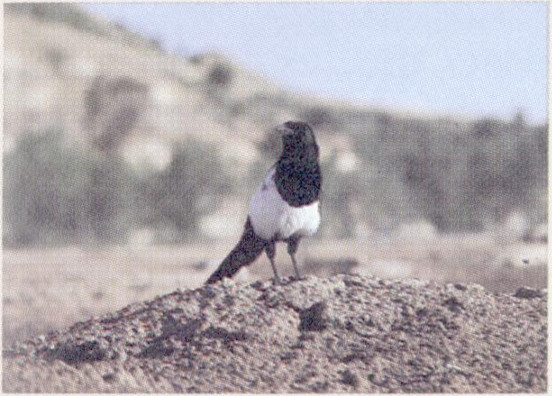
Standing still or in flight, the black-billed magpie is distinguished by its white shoulders and belly, by white patches under its wings, and by its long tail.
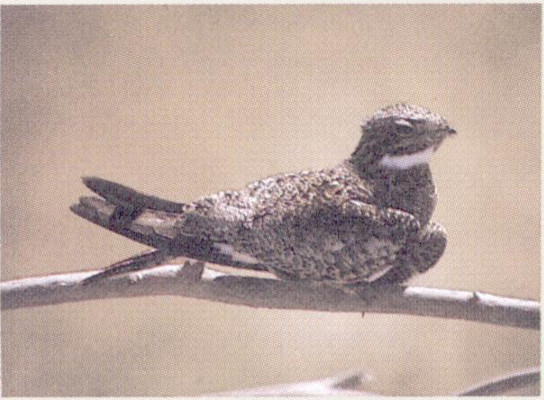
The nighthawk nests in the open grasslands here. This robin-sized bird was mistaken for a hawk by the pioneers because of its long wings and swift flight.
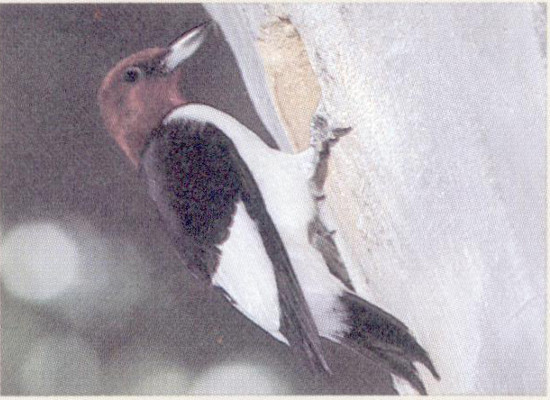
The red-headed woodpecker spends most of its time in the open deciduous woods. Its entirely red head and a large white patch on its wings distinguish it from other species.
The meadow across the river is a solid yellow of blooming spurge. In contrast, the ground on the Monument side of the river presents only a few isolated plants, and they are limp and pale from the effects of herbicide. Because spurge is an exotic plant that invades grasslands and displaces native flora, it is exterminated, through selective application of herbicide, within the Monument boundaries.
The rattle of a kingfisher precedes its sudden appearance around the sharp bend in the river. Skimming low across the water, the blue and white bird darts upward to perch on a cottonwood snag that overhangs the river. Its large crest and straight bill make the kingfisher look more caricature than real. Intently studying the river below, it need not wait long before plummeting from its observation post straight into the water. Reappearing a second later, it quickly regains its perch, the silver glint of a small fish caught in the parted scissors of its black bill. After swallowing the fish with a toss of its head, it shakes the water from its feathers and resumes its patient inspection.
Like a giant, soundless mosquito, a cranefly rises upward from the river bank. Another hovers low across the surface of the water, frequently dipping its abdomen below the surface to deposit its eggs. The first quickly disappears with the banking flight of a nighthawk; the second with the darting intercept of a dragonfly. Like countless other species of insects that divide their lives between the water and land, the craneflies are a living link in the food chain that helps bind the aquatic and terrestrial life communities together.
The many thousands of insect species requiring an underwater environment for their larval stage help sustain many species of terrestrial predators when the insects emerge from the water as adults. The kingfisher that nests here and the occasional great blue heron that stops during migration also enjoy the fruits of the water community, taking fish and frogs. But the process is not a one-way street. Nutrients leached from the land help fertilize the aquatic food chain. And the grasshopper that inadvertently hops into the river, only to disappear quickly into the gullet of a fish, represents another of the ongoing exchanges between land and water.
As I round the sharp bend that sends the river 47 flowing north again, a muskrat hurries into the water and submerges. On the steep bank high above the river, I wait until it surfaces in midstream. It floats lazily for a while, its long, naked tail straight with the slow current. Then it heads back toward shore. Across the river, the floodplain cottonwoods bear the scars of beaver teeth. Some are girdled and dead. Others are in full leaf despite deep but incomplete incisions.
Growing dusk fills the river valley. In the failing sunlight vanquished to a thin, vertical display on the Tower face, it is almost possible to imagine what this splendid landscape must have been like as wilderness. Bison, not cattle, would have grazed nearby. Instead of the howling dog that has escaped the campground and races into the prairie dog town, a wolf might be pressing home its attack on an injured pronghorn. Grizzlies and cougars knew this valley, and the river was tamed not by a nearby reservoir but by a latticework of beaver dams.
There are no prairie dogs left above ground now to challenge my trespass as I head back toward the welcome firelights of the campground. The deer have left their daybeds to graze in the open, and the great horned owl again asserts its dominance in the river timber. With a long rattle, briefly echoed from a cliff, the kingfisher quits the day.
Beneath the expanding population of stars, I return to the comfort of hot coffee and the confines of my own world. For now, I am content with the memory of eagle and falcon. In my mind they will continue to soar, inspecting the splendid terrain my memory today acquired.
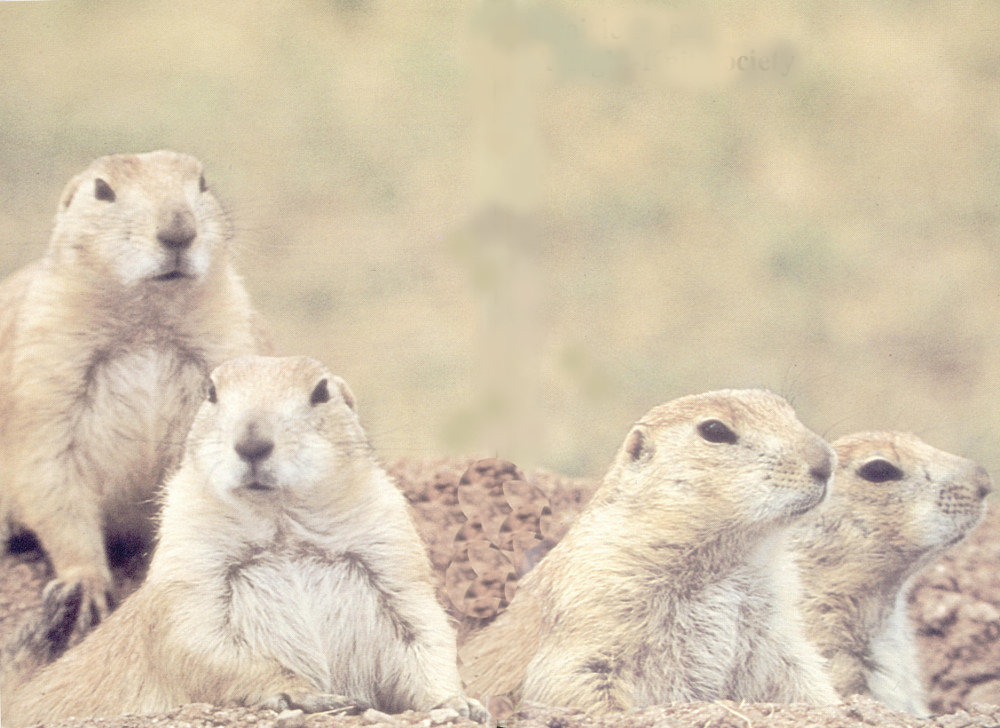
A prairie dog family gathers at the entrance to their burrow, watching the activity in the town and keeping an eye out for intruders.
When the long grip of winter’s crusted snow relaxes, pasqueflowers burst forth in ravines, unplowed pastures, and abandoned cemeteries. Their delicate silvery purple contrasts with the bleak stubble of last year’s ruined grasses. Before plows ever broke the grassland sod, pasqueflowers were so profuse the distant ground seemed veiled in haze. The pioneers called it “prairie smoke.”
With the appearance of the pasqueflowers, spring begins to renew the sun-warmed ground. Gone are the long days of waiting. Perhaps, the few prairie-dog sentinels that had stood motionless in the March wind wished that the spring would come. The sharp wind divides the dense fur of their winter coats while they survey the snow-skiffed ground of their silent town. They almost appear to regard the sun wistfully, wishing it strong, the snow gone, and the grass resurgent once again. But at last the meadowlarks lose their winter-long quiet, and the horned larks now lift up with extravagance, unhuddling from their long ordeal. Below ground, in the deep, secure warmth of their nursery chambers, a new generation of prairie dogs is developing, part of the ancient ritual of replenishment that spring brings to the Great Plains.
The breeding season of the prairie dog is determined by geographic location and weather conditions. On the southern plains of Texas it may be as early as January; on the Canadian plains as late as March. For four or five weeks there is much kissing, grooming, and investigation. Males become aggressive and squabble over territory. Besides the older females, perhaps half of the yearling females will mate.
After a month’s gestation, the litters are born. In the dark quiet of specially prepared nesting chambers, the babies appear, hairless, sightless, uncoordinated, weighing but 14 grams (0.5 ounce). They live in grass-lined nests for seven or eight weeks, attended almost constantly by the females as they develop. Growth is rapid. At 28 days they are crawling, and by 32 days the finely furred pups can walk and bark. Soon their eyes open and they fully resemble the adults. Until now the pups have known only darkness, blind passageways, and a single adult. One day soon they will be led upward.
That first moment above ground marks for them another birth. Now their senses experience a sudden 51 flood of light and sound, coolness, wind, a world of shape, motion, and perspective, whose staggering brightness extends forever beyond their own rim of familiar scent. Huddled together and shivering in the wind, they are at first loath to accept this world of sight and sun, so different from the soundless wrappings of dark, warm soil. But soon, as with all young animals, curiosity leads them to investigation and then to boldness.

The range of the prairie dog extends from Canada to Mexico and at its widest point from eastern Kansas to western Utah, with the blacktail’s range a bit more extensive than that of the whitetail. The range of the rare black-footed ferret, a predator, is nearly identical. The prairie dogs protected at Devils Tower are blacktails.
Each day the young spend more time above ground. Nearby, the mother remains alert for danger and solicitous, accepting the maulings of her playful and increasingly independent pups. Although ranging farther and farther afield, they remain obedient to their mother, and scamper back to their burrow when commanded. The first few weeks above ground is a time of weaning, learning, and conditioning.
During their first few days in society, pups have the run of the town. Boundaries that adults respect do not exist for them, as they wander about, inspecting every feature of their new world. The young have an insatiable need for body contact and much time is spent at play, and in grooming and kissing, activities that seem to reinforce the social nature of the prairie dogs. Adult males tolerate the young for a time during this period of general acquaintance. At first the pups attempt to nurse from any adult they encounter, and these misguided attempts are not rebuked, even by the males; they are turned into grooming sessions.
Life on this greening land seems too good to be true. Entertainment is everywhere. Grasshopper nymphs, which the adult prairie dogs occasionally capture and consume unceremoniously, provide them with hours of chase and stalk. Food is everywhere and easy to obtain. Imitating their elders, the pups sample the wide array of grasses and forbs surrounding every burrow.
Like the young of all the other animals they see, the pups have no way of realizing that their debut coincides with the season most favorable to their survival. So they scamper about in witless abandon, uncautious and innocent, ignorant as yet of the harsher outlines of their world. For a time, their place in the community is as idyllic as the soft-winded afternoons of spring. But on the Great Plains, spring is at best an uncertain season, its lifespan often 52 breathtakingly short. As the days pass, the dominant males that patrol their territories rapidly lose patience with neighboring pups. Those that stray outside the invisible boundaries of their clan’s living-space are now met with annoyance. Soon the displeasure turns to snarls and bites. More and more, their own mothers refuse them milk. Nipples bleeding from the constant pesterings of their young, the mothers finally move out altogether, to establish new burrows of their own.
To survive predatory perils, the new generation of prairie dogs, like countless previous ones, must master a two-pronged defense system evolved over millions of years. First, the pups must learn to engineer a burrow system with alternate escape routes. Second, they must learn to live in a highly organized social order, heeding its signals and respecting its boundaries.
Prairie dogs are divided into two general classes, the blacktailed and the whitetailed. Blacktails inhabit the semi-arid regions of the Great Plains; whitetails live in the higher elevations of mountain parks and foothills. But it’s difficult to generalize, for Devils Tower and Wind Cave National Park, in South Dakota, are in the Black Hills and the prairie dogs at both are blacktails. The dog town at Devils Tower occupies a level grassland bench between the Tower’s base and the nearby meandering Belle Fourche River. Blacktails are protected in their more typical arid topography at two other National Park System areas: Badlands National Park in South Dakota and Theodore Roosevelt National Park in North Dakota.
Generally, as a result of dissimilar habitats, the two species exhibit slightly different patterns of behavior. Unlike the blacktails, which emerge to forage on sunny winter days, whitetails are confined to their burrows by deep mountain snows. Those at high elevations must hibernate to survive the long winter.
The whitetail community is a much less highly developed social structure than the blacktail community. The animals are unable to enjoy the luxury of long summers. In the short season they must spend a great amount of time feeding to store up body fat for winter. They have little time for social rituals—grooming, greeting, or play. Time does not allow them to establish and maintain territories.
The burrow is to the prairie dog what speed and 53 endurance is to the pronghorn: its chief means of protection. Yet it is more than just a hole in the ground, a temporary refuge from the threat of danger. More than half of a prairie dog’s life is spent below ground, so the burrow must accommodate a wide range of needs (See pages 56-57.).
Often old burrow systems are abandoned and new tunnels excavated. The debris from the new tunnel system is dumped into the old burrows. These plugged burrows, called cores, may, in time, be more extensive than active tunnels in a long-occupied town. Whether knowingly or unknowingly, the prairie dog, by plugging unused passages, is practicing sound engineering; if all excavated material were brought to the surface, the weakened sub-surface, riddled with tunnels, would begin to settle and the burrows would eventually collapse.
As with the beaver—the only North American mammal whose engineering feats surpass the prairie dog’s—it is often difficult to distinguish instinctive behavior from actual problem solving. Burrow systems vary from individual to individual and with local topography. However, as early attempts to “drown out” prairie dogs soon proved, the overall design of their burrow networks minimizes the dangers of flooding. While the lower angle of the tunnel may fill with water, the portion of the burrow that culminates in the sealed escape hole serves as an air bell, preventing a further rise of water and protecting the animal from being flooded out of its sanctuary during periods of heavy rain. Not realizing that prairie dogs can live without water—as can many other plains mammals that manufacture metabolic water from foods they eat—instigators of attempts to drown out the animals concluded that the animals dug down to ground water. The myth of the “town well” persisted until well diggers discovered that the water table in most townsites was hundreds of meters down.
More than once their burrows have saved them from talon and teeth, and they take care to maintain the mounds surrounding the entrances to their tunnels. These structures serve not only as watch-towers, but also as dikes against downpours that may temporarily turn a town into a lake.
But even instinctive digging habits and well engineered burrows, by themselves, would not have permitted prairie dogs to achieve their once staggering population levels—estimated to have been about 25 billion individuals. Only through the additional benefits of some form of social organization and an effective means of communication could such success have been attained.
continues on page 58
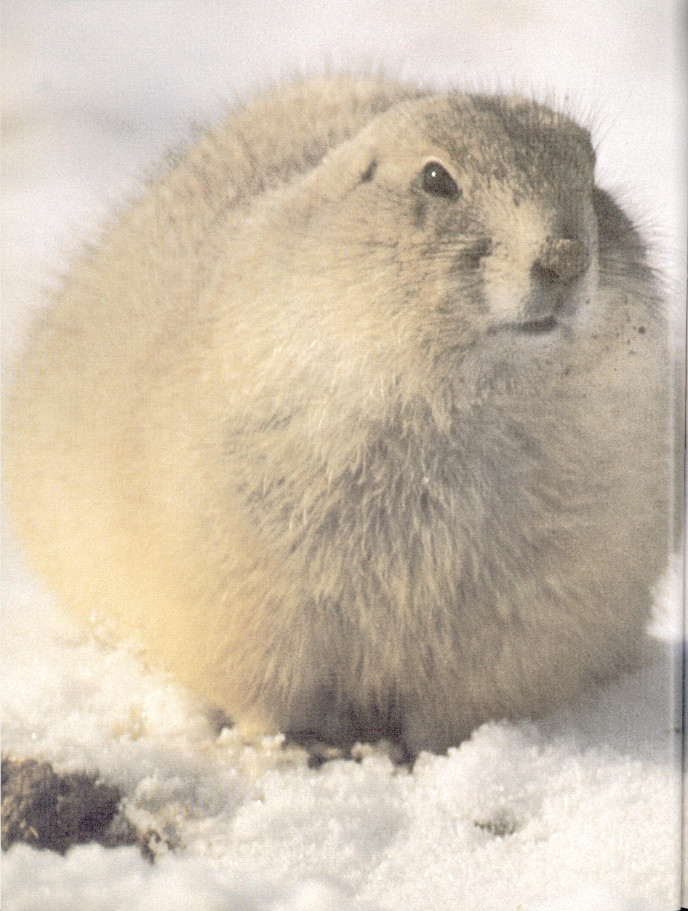 55
55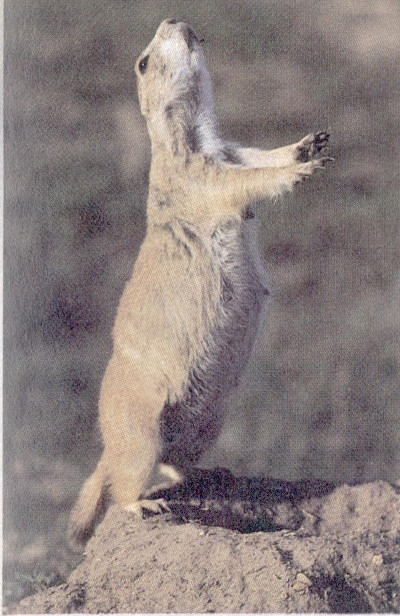
A prairie dog sounds the alarm, alerting the whole town about an impending danger, such as a coyote, a ferret, or a person. The rest take up the call, and as the danger approaches each burrow the inhabitants duck underground. The others continue to stand erect and sound the warning. By listening carefully, those underground can track the location of the enemy. When two high-pitched notes are sounded, all rush for cover, for that means a hawk is overhead or nearby and there’s no time to wait and repeat the signal. After the danger has disappeared, a dog sounds a melodic whistle, and a few others repeat the all-clear before the usual activities of grooming, breeding, eating, and burrow building are resumed. Blacktails make at least seven other calls, but they mostly concern matters of interest to the coterie, or family, instead of to the whole town.
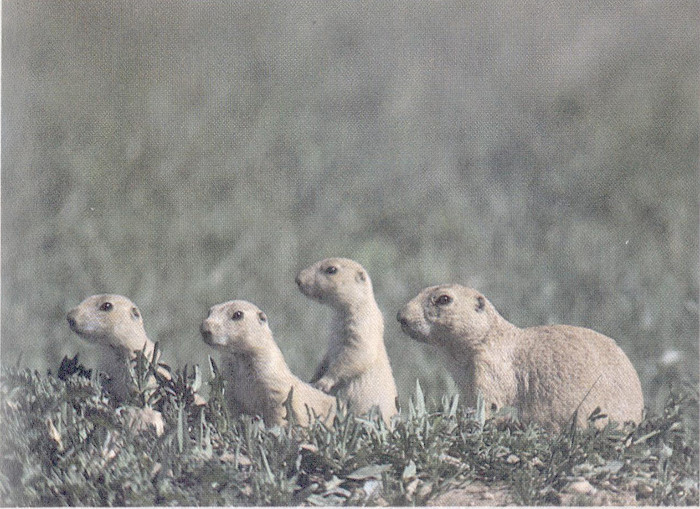
After spending a little more than a month below ground, newborn pups warily venture into the daylight, closely watched by their mother. They soon lose their timidness, venturing farther and farther from the burrow but remaining obedient to mother’s commands. Most of the first few weeks on the surface are spent mauling, kissing, or grooming each other and their parents. As the weeks go by, the adults tolerate less play and the pups learn more and more day-to-day survival responsibilities.
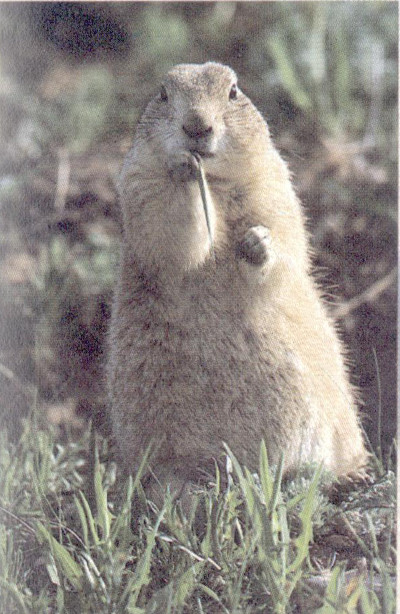
A prairie dog eats a blade of grass sitting on its haunches. After falling over a few times, pups soon learn this dining posture. The dogs eat various grasses and forbs, though for different periods they tend to ignore some plants in favor of others. However, they usually clip off all vegetation around their burrows even if they don’t eat it. This habitual grass-cutting apparently is defensive, for predators can conceal themselves better in tall grasses. That is why you don’t see prairie dogs in lush grasslands where there is a bountiful rainfall. They satisfy most of their needs for water with the juices of green plants and grass roots.
Prairie dogs also eat insects that inhabit their towns and sometimes prey upon the eggs or young of animals, such as the burrowing owl, that dwell in homes deserted by prairie dogs.
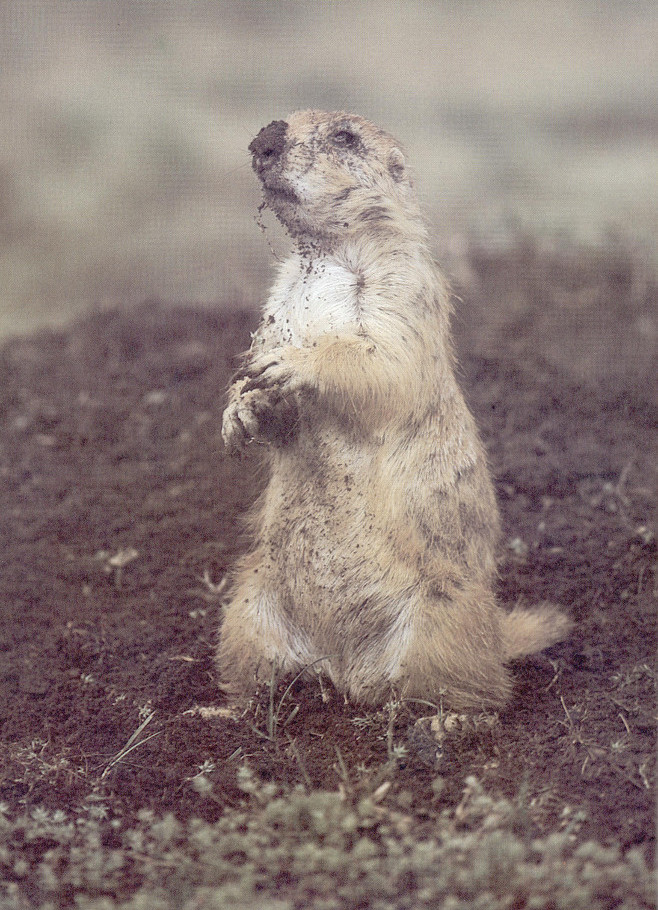 57
57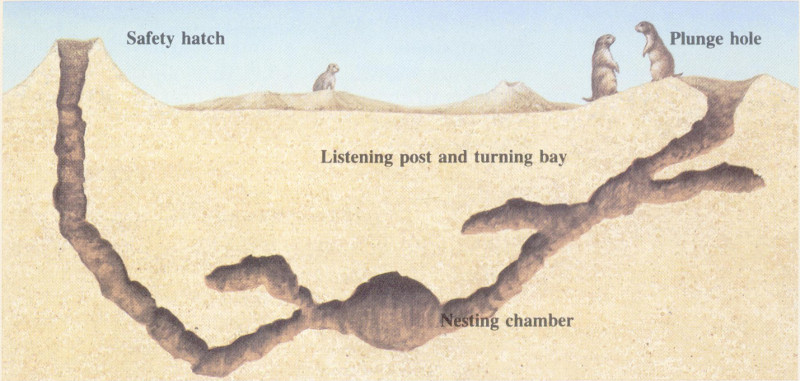
Viewed in a cross-section, a typical prairie dog burrow system reveals a network of tunnels and compartments. The slightly oval entrance, 10 to 15 centimeters (4 to 6 inches) in diameter, leads the prairie dog rapidly downward. This plunge hole soon tapers off into a more gentle slope that may descend another 4.5 meters (15 feet). The burrow then turns upward and approaches the surface about 9 meters (30 feet) from the entrance hole. In an emergency this safety hatch can be quickly opened and the prairie dog can escape entrapment. Every burrow contains several rooms to accommodate various needs. The first room the prairie dog encounters as it travels down the plunge hole is known as the antechamber. which is large enough for two animals. It functions as a turn-around, permitting entering and exiting animals to pass one another. But primarily it is used as a listening post. Before venturing out in the morning, a prairie dog pauses here, on the alert for possible danger. From this room it can monitor the situation by listening to alarm calls of neighbors still above ground. The nesting chamber may be found most anywhere in the burrow, but usually it is associated with the main passageway above the lowest point, to protect it from flooding. Lined with grasses and other soft plant fibers, the nest affords a degree of comfort and insulation against cold and dampness. Perhaps because of accumulating litter or parasites, such as lice and fleas, the location of the nest chamber is often changed.
- Safety hatch
- Plunge hole
- Listening post and turning bay
- Nesting chamber
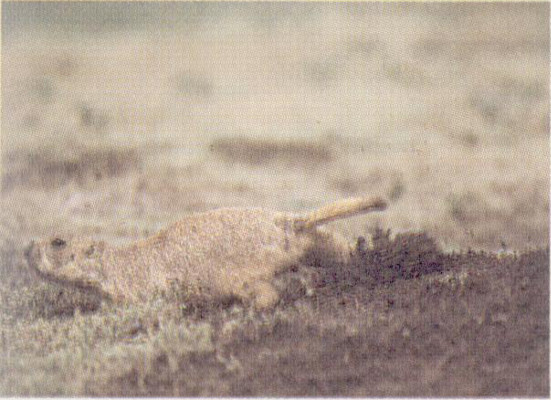
Blacktail prairie dogs build hard-packed ridges around their burrow openings as watchtowers and as dikes against downpours. A prairie dog uses various skills in this work, including, above, scraping dirt with its powerful hind legs.
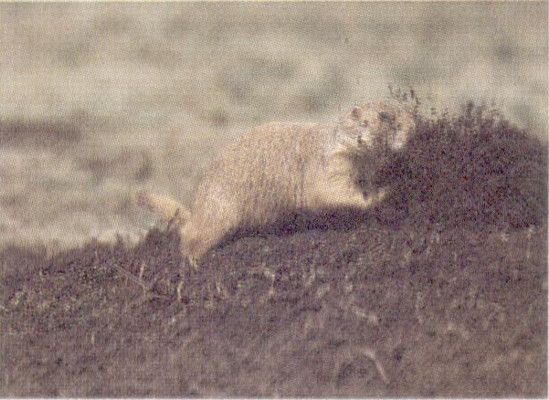
Mound-building also calls for bulldozing earth with the prairie dog’s hard, blunt nose. Both excavated subsoil and topsoil are pushed around to build up the mound. Whitetails tend to merely leave an unworked pile of subsoil around the entrance.
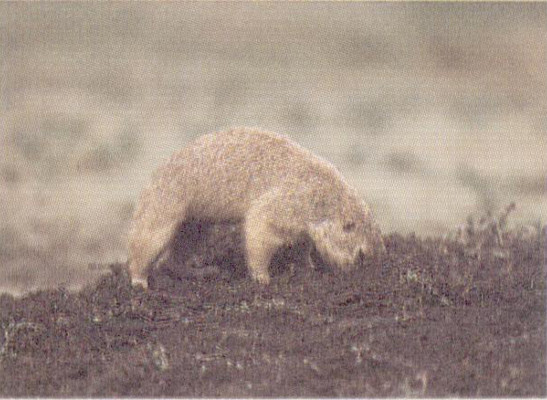
After tamping the freshly loosened earth with its nose, above, and at other times in the whole process, the prairie dog takes a break and cleans its long claws, page 56, and its nose.
Gregariousness is a common trait of many plains animals. In a land where movement is necessary and concealment difficult to achieve, it provides a definite survival advantage. Bison calves find protection in the herd, where their defense is the concern of all adults. Pronghorns take turns as sentries, allowing the other members of the group to rest and feed. Coyotes are more effective when hunting in pairs. The success of the wolf in bringing down large prey and even evicting grizzlies from their kills was largely due to their family group or pack organization. But lacking physical adaptations for speed and mobility, prairie dogs are forced to rely on their burrows for refuge. The need to remain close to their burrows imposes on the animals a serious problem: how to maintain an adequate food supply?
Although a dog town might appear to be one big collection of affectionate family members, all coming and going at will, the impression is false. Instead, each town is divided up into small groups of related animals. These family groups, called coteries, are the basic social unit, much as human families are in our own society. As the prairie dog pups soon learn, each coterie defends its own territory from intrusion by others, thus preserving for itself necessary living space and an adequate food supply close to the safety of its own burrows. Only in times of dire emergency, when the scramble to safety supersedes all territorial claims, will prairie dogs allow other coterie members the use of their burrows. So strong is an offending animal’s sense of trespass, it will often brave the hazard of dashing back to its own burrow rather than staying long in a neighbor’s territory.
The typical coterie consists of about seven to eight animals, arranged in a hierarchical order. Each usually has a dominant male that protects the coterie’s territory from invasion by other males and oversees the activities of the females and young. If the coterie is a large one, more than one individual may enjoy dominant status and share the duties of leadership. In some cases, females may be dominant in rank; 59 the role generally falls to the males, however, possibly because of their slightly larger size or because they have more time to observe and patrol, not being tied to the demands of the young.
Not only their social organization, but also their social behavior makes prairie dogs unique among rodents. The function of coterie hierarchy is cooperative, rather than oppressive, resulting in a remarkable absence of conflict and social stress. Aggressiveness is generally limited to inter-coterie contacts along the invisible boundaries. In an established town, infractions are usually accidental and seldom precipitate lasting disputes. The end result of intra-coterie cooperation and inter-coterie respect is a stable and harmonious town. Energies and attention that would otherwise be squandered in conflict can thus be focused on mutual defense.
For brief periods during spring and fall, the strict laws of territoriality are relaxed. In spring, the period coincides with the appearance of pups. Not only does this prevent undue strife in the community over the wanderings of the socially ignorant pups; it also allows those females seeking new territories to cross established ones. In the fall, the period is also necessary, accommodating the dispersal of overcrowded family groups. During autumn, the urge to emigrate is strong, and many animals move out into the “suburbs” of the town. Thus the town maintains a degree of flexibility and avoids permanent pockets of overpopulation.
Coterie members maintain mutual recognition through an often-repeated ritual involving mouth contact. Prairie dogs that appear to be “kissing” or “talking” are simply establishing identities. Generally the most dominant member will initiate mouth contact, approaching the second animal with head tilted back and presenting its open mouth, to which the other responds in like manner. Often the recognition ceremony is accompanied by tail wagging and frequently leads to another form of social reinforcement, the process of grooming. Generally, the prairie dog that initiates the mouth contact does the grooming, nibbling, and combing the fur in an effort to dislodge dirt and parasites. The act is more significant for its symbolic value, however, for the animal of lower rank will often completely roll over on its back during the process; by exposing its vulnerable undersides, it is submitting, canine fashion, to the dominance of its fellow. Pups that annoy adult males with their attentions are often rather roughly groomed. No doubt the procedure communicates authority as well as affection.
continues on page 62
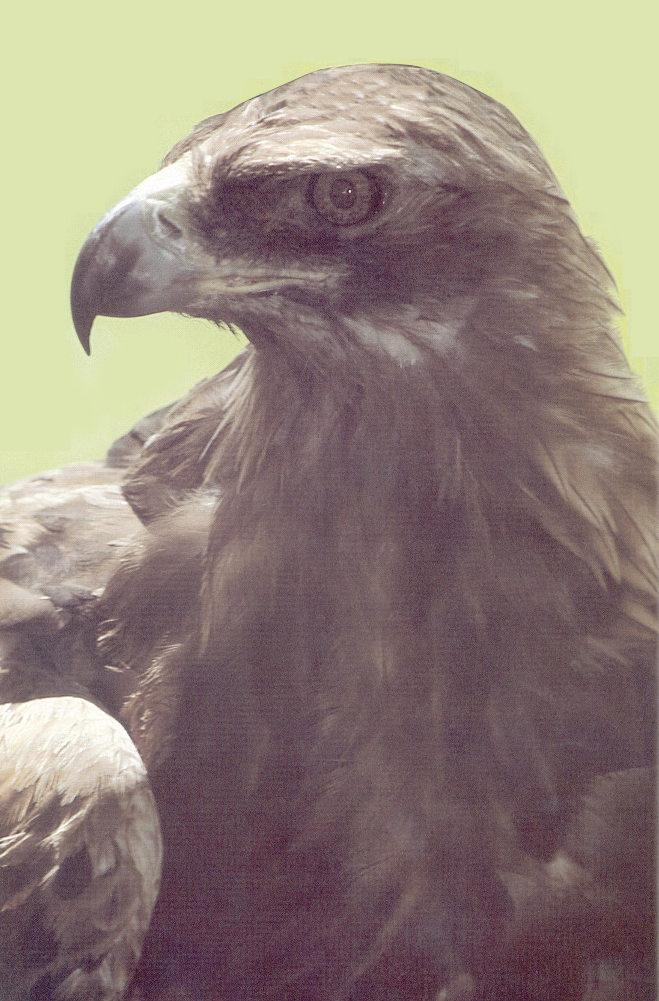
A shadow races across a prairie dog town, stirring up a sudden panic of alarms and dashes to safety. A shriek stills the community. Overhead, the squeals of an unwary pup rapidly diminish as it is carried off in a clutch of gleaming talons of a golden eagle, above, to a nest of hungry eaglets, below.
61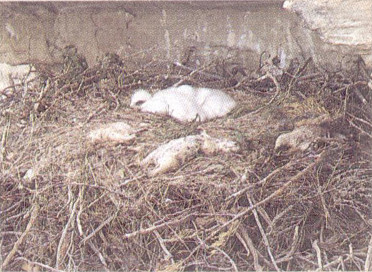
Many pups and some adults are lost to predators. While small, prairie dogs are fair game for rattlesnakes and burrowing owls. Hawks, like the eagles, ambush pups from the sky. Patrolling coyotes are quick to sense the pups’ hesitation and to capitalize on the uncertainty. Badgers excavate with astounding speed; bobcats rush from concealment of any nearby cover. And in some places the most dreaded predator of all is the black-footed ferret, which enters the burrow itself to surprise and trap its prey. But eradication programs against the prairie dog have made the ferret nearly extinct; none has been seen at Devils Tower since the late 1800s. Some of the other predators of the prairie dog also have been nearly eliminated by man. And with the loss of natural predators, prairie dog populations flourish rapidly. Unless these predators are allowed to make a comeback, prairie dog control programs will be inevitable.
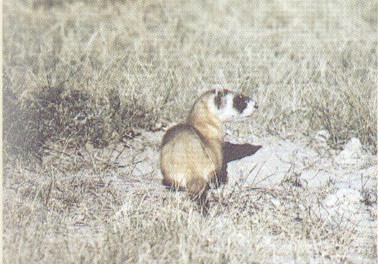
The black-footed ferret, a large weasel, makes its home in prairie dog towns, but it is extremely rare.
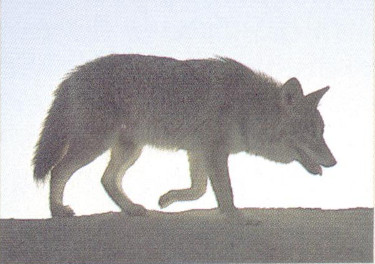
The coyote frequently prowls prairie dog towns in the early morning and evening.
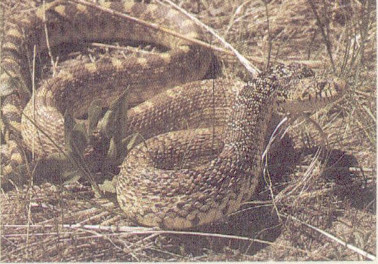
The bullsnake hangs around burrows to prey on pups and other small rodents, killing them by constriction.
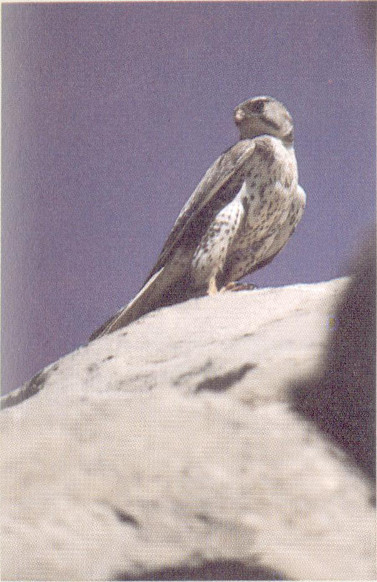
The prairie falcon nests on the Tower and occasionally feeds on residents of the prairie dog town.
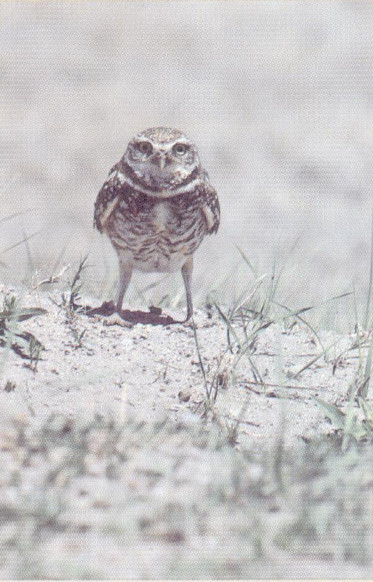
The burrowing owl often nests in old burrows and sometimes preys on pups. Prairie dogs eat owl eggs and young.
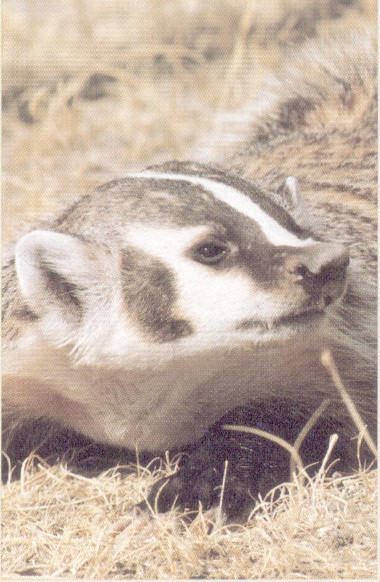
The badger is short, broad, and a formidable digger. It concentrates its preying on new, one-entrance burrows.
Should the individual invited to mouth contact not reciprocate, an immediate challenge is made. Apparently, mouth contact is the only positive means of identification available to prairie dogs, and any animal refusing it is immediately deemed a trespasser and aggressively evicted. The wild chase that ensues, accompanied by indignant calling and fierce chattering of teeth, sometimes leads the righteous landowner deep inside its neighbor’s territory. The roles abruptly reverse and, after a moment of mutual realization, the pursuer suddenly becomes the pursued.
In the glare of the early evening sun it is difficult to distinguish the individual prairie dogs as they go about their various activities. A single warning call, however, and the town instantly sprouts battalions of erect postures. For a moment, each motionless, backlit figure shines its sun-haloed position. All the disparate activities of the scattered animals become instantaneously fused to a single purpose: identifying the danger.
Vocalizations distinguish the prairie dog from all other rodents. At least ten different calls have been identified in the blacktail class of prairie dogs. Most of the calls—such as the challenge bark, defense bark, disputing “churr,” fighting snarl, fear scream, muffled bark, and tooth chattering—do not involve the entire community. Except for the fear scream, which is immediately noted by all members, these vocal signals are largely ignored by neighboring animals since they usually denote a local disturbance among the prairie dogs themselves. There are three warning calls, however, that are intended for the entire community; these constitute the bond that unites all the separate coteries of the town into a single social unit.
At the sound of the warning bark, usually uttered by many animals at once and quickly relayed through the entire town, each prairie dog immediately rises to alert in an attempt to define the immediate danger. If the wave of alarms is particularly intense, the animals usually rush to burrow mounds, where they will await further developments. Usually only the 63 prairie dogs in the immediate vicinity of an enemy will retire below ground. The remainder of the population continues to observe and sound the alarm. As an enemy approaches a particular burrow, the frequency and intensity of the occupant’s warning bark increases. Only at the last moment will the prairie dog cut short its tirade, capping it with an indignant churk as it dives below ground.
Another, more urgent, signal is the hawk warning call. The high-pitched, musical twin notes of this cry prompt an immediate dash for cover. Unlike the typical reaction to the warning bark, response to the hawk warning call is unhesitating. When this cry is given, seconds count, and visual confirmation of danger is not required to prompt a rush to safety.
After danger has passed, the all-clear is sounded. Known as the song bark, this melodic whistle is always associated with a particular body posture. Rising up on its haunches, the prairie dog points its nose to the sky, gives the whistle, and promptly falls back on all fours. When learning to execute this call, pups usually topple over backwards. Once uttered, the call is repeated sporadically throughout the town.
Communication is as important to the survival of the prairie dog society as is adequate food and shelter. Towns decimated by disease or poisoning soon vanish if the survivors are too few or scattered to communicate effectively. Deprived of an efficient warning system (and perhaps of the psychological need of social contact, as well), individual animals make easy targets for predators. Certainly they are too large and conspicuous to blend in well with their sparse surroundings. Unlike their small, well-camouflaged cousins, the thirteen-lined ground squirrels, prairie dogs cannot survive as individuals.
After the females leave their weaned pups to establish new burrows for themselves, the young will remain together for a while until they, too, begin to split up. No longer do they resemble the playful, romping pups of spring, annoying their elders with their ceaseless games, demands for attention, and disregard for territorial boundaries. Now full-fledged members of their clans, they capture grasshoppers in a business-like fashion. Like the season, they have matured. With the company of their elders they now share a suspicion of the sky and every uninspected plot of ground.
In the early days of the cattle range, before sound land management of the plains was understood, cattlemen were perplexed to witness mushrooming populations of prairie dogs. Formerly lush grassland often became a dog town “wasteland” following the introduction of cattle. Believing that the prairie dog, and not the cattle, was responsible for this sudden transformation, ranchers rapidly came to despise prairie dogs. A massive war of extermination began against these “varmits” that “ate the grass down to nothing.” In reality, the appearance of prairie dogs merely indicated that the land was being overgrazed. As the bison had done before them, cattle now began to open up to the prairie dogs new territories that they could not otherwise colonize. Prairie dogs were never found on the eastern prairies simply because they could not contend with the taller growth of the more humid grasslands.
On their own, prairie dogs cannot easily invade unbroken areas of established grassland. The grass cover simply rejuvenates faster than the animals can work. But if the land has been disturbed by overgrazing, prairie dogs can quickly spread. Once established in an area, the animals wage a constant struggle against the vegetation. Since tall-growing plants offer concealment to a predator, the plants are routinely clipped off even if they are not to be eaten.
The feeding, clearing, and burrowing activities of the dog town tend to retard the grasses while encouraging the persistence of forbs—the broadleaf plants that quickly invade disturbed ground but are eventually crowded out by the returning grasses. By arresting the normal process of plant succession, an active dog town delays the return of the site to its climax vegetation of grasses. In so doing, it inadvertently perpetuates a wider variety of plants than would otherwise be found on the site.
Selective feeders, prairie dogs put pressure on a particular plant species when it becomes most abundant, then ignore it almost entirely in favor of another, and so on. This cyclic feeding allows each species to recover, preventing it from being eliminated.
Dry years help the prairie dog maintain control over the vegetation, and thus favor town expansion, while wet years speed recovery of the grasses and 65 work against the town. Towns that had spread into lush grassland during the favorable conditions of drought may be severely reduced or even eliminated with the return of adequate precipitation.
In some cases, the clearing activities of prairie dogs may actually speed plant succession. As a direct result of overgrazing by domestic stock, much of the grassland of the semi-arid West was invaded by sagebrush, a tough, drought-resistant plant that tends to perpetuate itself indefinitely once introduced. By cutting down the sage, prairie dogs eliminate it from the plant community and open the land to grasses.
In its struggle for control of territory, the prairie dog was aided by the bison. The vast herds that moved across the landscape like a black plague of giant locusts left choice tracts of the grasslands devastated in their wake. The effects of such a physical force are difficult for us to comprehend today. Migrating northward in huge columns that sometimes measured 80 kilometers (50 miles) across, the bison cropped and trampled the greening spring grasses. Surely when the bison and the prairie dog were finally replaced by cattle, the grasslands, free at last from such punishment, would flourish. But no, instead the grasses languished. How could this be so?
Nature is always more complex than our perception of it. For countless centuries the Great Plains had survived its many moods of drought, dust storm, and wildfire, its scattered plagues of bison and grasshopper. Nature knows no “varmits,” and change is not catastrophe, but opportunity. But to the settler who shot hawks, owls, and eagles to protect his calves, poultry, and children, the lesson was a long time dawning.
Ironically, the grasslands needed the periodic despoilment of bison and burrow. When the bison herd moved on, it left behind tons of fertilizer, key to the area’s future rejuvenation. But the millions of hoofs also left the ground compacted. Were it not for the ceaseless activities of countless burrowing animals, including the industrious prairie dogs, loosening the soil and undoing the damage, the bison would have eventually destroyed much of their range.
For an animal so successfully adapted to life on the unrelieved expanses of the open plains, it is ironic that today prairie dogs survive in isolated colonies at the very margins of its desirable habitat.
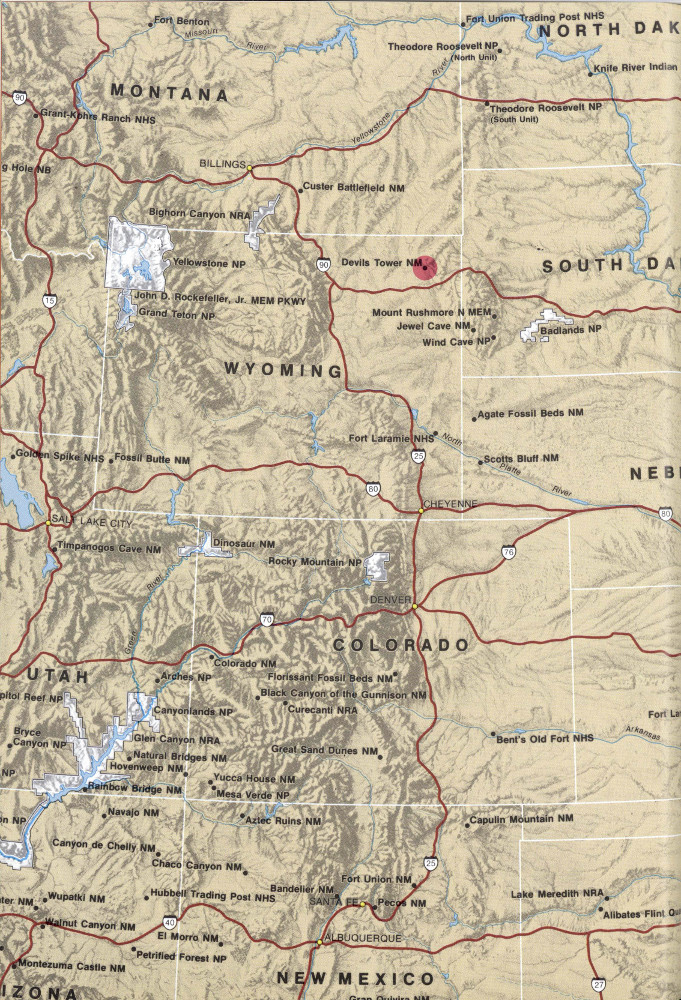
National Parks
High-resolution Map
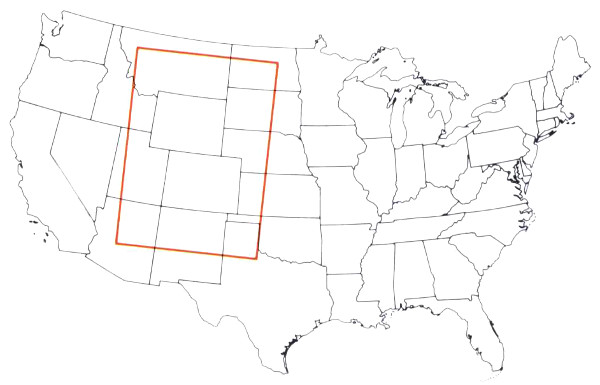
The map comes from the “Guide and Map, National Parks of the United States,” a brochure that may be purchased from the U. S. Government Printing Office. For information on roads leading to Devils Tower, see the next page.
On the fringe of the Black Hills in northeastern Wyoming, northwest of Sundance, northeast of Moorcroft, and southwest of Hulett.
545 hectares (1,347 acres).
The park is about 1,290 meters (4,250 feet) above sea level. The Tower rises another 264 meters (867 feet) to the top.
Summer temperatures cover a wide range from daily highs of 29°C (83°F) to lows of 10°C (50°F). Winter temperatures plunge below freezing for long periods of time. Spring arrives usually sometime in April, but the temperature drops quickly at night and stays cold during the day if it’s cloudy. About the end of September, fall begins, and with it the golden color of changing cottonwood leaves along the Belle Fourche River.
Spring is short in the Rocky Mountain West and can be a time of violent shifts in weather: summerlike days alternating with cold, always the possibility of late heavy snowfalls, and no inbetweens. These extremes seem to be tempered somewhat at Devils Tower, and the fun of watching deer can more than make up for any inconvenience due to the weather. Whitetail deer, followed by their spotted fawns, are rubbing off winter coats. They seem to be browsing the park hungrily everywhere you look.
Summer heat, because of elevation and dry air, radiates quickly but never becomes stifling. Winds are strong and steady and there is always a danger of exposure for those unprepared for sudden 70 thunder and lightning storms, or for the sudden cooling after sunset. Most visits to Devils Tower are made in the summer when the surrounding rangelands are green and the sparkling watercourses invite refreshment under shade of cottonwoods.
Early fall, just as the range begins to brown, is perhaps a perfect time to be at Devils Tower. The park is uncrowded after Labor Day. Protected meadows are still green. Animals are in their prime and ready for the rigors of winter. The faint odor of decaying vegetation and the foretaste of winter on a particularly bracing chill wind—these are the pleasures of a long Wyoming fall.
Winter brings an air of enforced isolation to Devils Tower. Heavy snows and frequent blizzard conditions on the highways discourage most travelers. A rare treat awaits those who do come here in winter, however. Bald eagles migrate down from the north. You might see them wheeling in pairs over an otherwise frozen landscape, or making a feast of carrion on the ground.
Highways—From Rapid City, S. Dak., take I-90 west to Sundance. Wyo.; then U.S. 14 to Devils Tower Junction; then Wyo. 24 to park. From Gillette, Wyo., take I-90 east to Moorcroft, then U.S. 14 to Wyo. 24. From Newcastle, Wyo. take U.S. 16 to Moorcroft. From Belle Fourche, S. Dak., take S. Dak. 34 to Wyoming line, then Wyo. 24 via Hulett to park. Buses—Nearest regularly scheduled buses serve Moorcroft; no service to park. Railroads—Nearest rail passenger service is in Cheyenne. Airport—Rapid City Airport is served by a few commercial airlines. Cars may be rented.
For a general introduction to Devils Tower, the visitor center has exhibits, an audio/visual program, trail guides and plant and animal checklists, a publications sales outlet, and an information counter with a ranger on duty to answer questions. This is also the place where climbers must register to climb Devils Tower. The visitor center is open from about May 1 to October 31. In winter information requests are answered in the headquarters administration building.
The park has one campground for which a campsite fee is charged from about May 20 through September 10. Opening and closing dates depend on weather conditions. It has about 50 camping sites which will accommodate both tent and trailer camping equipment. A water tap, restrooms, fire grills, and picnic tables are provided, but there are no utility hook-ups for trailers. Campsites are taken on a first-come, first-served basis. After September 10, or later at the first sign of freezing, the water is shut off and the road is not snowplowed. Winter camping is allowed, however.
The featured program at Devils Tower is presented every evening during the visitor season in the campground amphitheater. The story of the nation’s first national monument is told with projected slide photographs by a park ranger who embellishes the story with colorful anecdotes about rangering experiences.
Even if you have only time for a half-day visit to Devils Tower, it’s time enough for a hike around the tower. Tower Trail is only 2 kilometers (1.25 miles) long and traverses fairly 71 level ground. It stays in forest shade while it skirts the jumbled mass of boulders lying at the base of the Tower. It is the only trail in the park with formal wayside markers and benches where you can stop and look at the Tower from close up.
The park has three other designated hiking trails, all of them longer than Tower Trail and generally uncrowded. Devils Tower is never out of sight for long though, so it’s not easy to get lost. The longer trails offer a chance to see different plant and animal environments; open meadows, prairie dog towns, bluffs overlooking the Belle Fourche River, the riverside habitat itself, as well as the pine forest, all of which are described in Part 2 of this handbook.
Motels, trailer courts, camping supply stores, and service stations are in the nearby town of Hulett. Just outside the park boundary is a post office, general store, and commercial campground with a few extra recreational offerings.
Proclaimed September 24, 1906. Boundary changes, August 9, 1955.
Devils Tower, Wyoming 82714.
It is unlawful to disturb, injure, destroy, or remove any vegetation or rocks. This basic rule is made not only to protect the natural resources but out of consideration for others who will be here in the future.
Do not feed the prairie dogs or let them get close to you; they carry fleas and they can bite you. Do not chase, harass, attempt to catch, or feed any park animals. Rattlesnakes usually don’t strike unless provoked or mistreated. Watch out for them! Hunting is not permitted in the park. If firearms and other weapons are carried, they must be unloaded and cased so as to prevent their use.
All pets must be kept in vehicles, or caged or leashed when in the park. They are not permitted in public buildings.
Drive carefully to protect yourself, others, and wildlife. Do not obstruct traffic by stopping on the road; pull over and let other vehicles pass. Driving off roadways is prohibited. Park on road shoulders or at parking areas only.
Camp only at the campground. Dump wastes and wash water in special sinks at the restrooms, not on the ground. Littering is both irresponsible and unlawful. Trash cans are provided at convenient places throughout the park; please use them.
Fires are permitted only in the fireplaces found in the campground and must not be left unattended. Thoroughly drown all campfires with water after use.
All climbers must register by name, address, and telephone number with a park ranger before going up.
And you must check out when you return. This is the only safety precaution on climbing required by the U.S. Code of Federal Regulations. Depending on your mountain climbing experience here and elsewhere, however, you might want to ask the rangers for safety hints, different climbing routes, and conditions on the face of the Tower at the time of your climb.
More than 80 separate routes to the top have been taken and described in the literature. No one has been killed climbing the Tower, a remarkable record. The most difficult pitches come first while there is still plenty of time to turn back or take an easier route. Also, compared to other mountains, Devils Tower can be conquered in a short time, less than an hour for the most skilled if they use an easy route. This means less chance of exhaustion from exposure. In sudden bad weather, one can easily rappel off in 40 to 60 minutes.
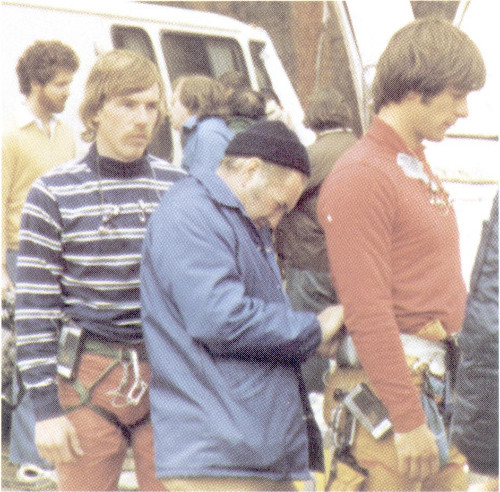
George Willig, in red shirt, and Steve Matous prepare to climb Devils Tower in 1979.
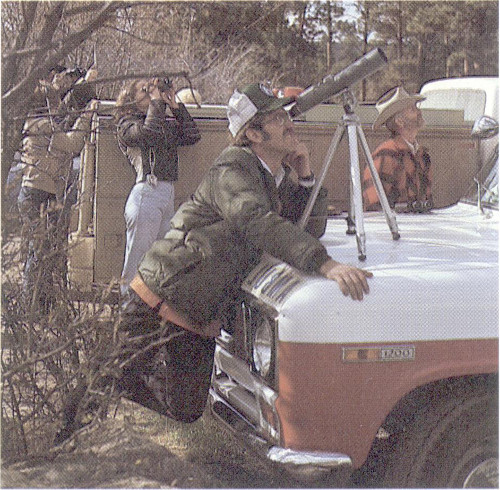
Their climb was witnessed by a national audience on a televised all-day sport show and by a large crowd in the park using telescopes and binoculars.
Records of climbs have been kept at the park since 1937. In 1963 the one thousandth climber checked in and in 1970 the two thousandth. Since 1977 more than 1,000 make the climb every year. The Tower has been climbed with the direct aid of ropes and pitons and with a technique known as “free climbing” without the use of ropes except as backup to catch a fall. It has been climbed from all sides and in all seasons, even on Christmas Day and on New Year’s Day. Some people, of course, prefer to climb the Tower in 73 snow and ice. One might conclude that all the “firsts” have been taken at Devils Tower, but, as long as the personal challenge of the sport continues to attract newcomers, there are certain to be more new records.
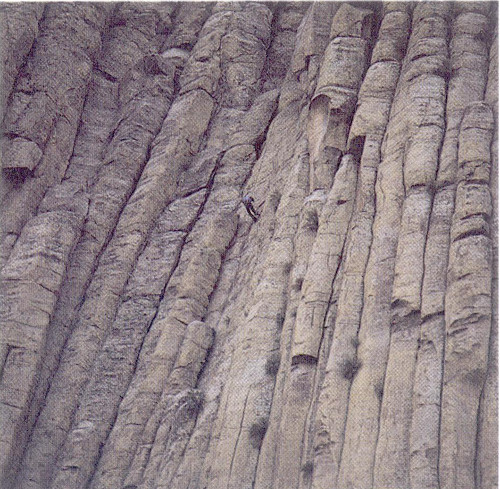
From the ground a member of the Willig party looks minute.
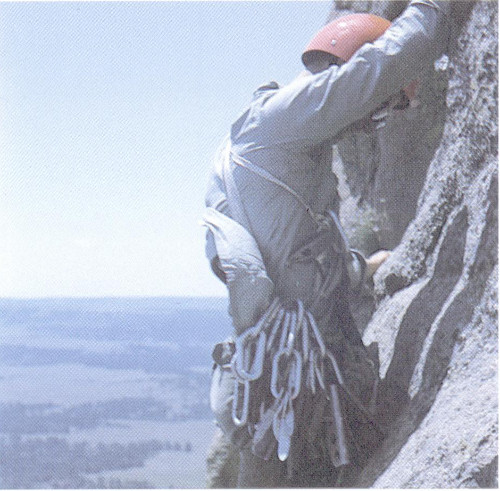
Up close, another climber ponders his next move.
August has been the most active climbing month in recent years. The heat on the south-facing side of the Tower presents serious problems though. Climbers usually try to start as early as possible before the sun has a chance to heat the rock blazing hot.
Climbers rightfully take interest in the geology of the Tower. Worming their fingers into cracks and fissures, depending for their lives on the ringing-hard igneous mass that supports them, rock climbers develop a familiarity with various origins and kinds of rock. They, of course, contribute to the ongoing process of erosion which, over eons of time, has left Devils Tower in its present form. The amount of loose rock that breaks off under their feet, however, is far less than the amount lost every season from frost-heave, the effect of water seeping behind the surface rock and expanding into ice. The boulder field at the base of the Tower tells the rest of the erosion story. By studying lichen growing on the last slab to fall off the side, it has been estimated that this event occurred more than 10,000 years ago.
is 40 kilometers (25 miles) southwest of Rapid City, South Dakota. Patriotic ideals representing the birth of the Nation through its entry into 20th Century world affairs are symbolized in massive stone carvings of George Washington, Thomas Jefferson, Abraham Lincoln, and Theodore Roosevelt. The scale and difficulty of sculptor Gutzon Borglum’s achievement perhaps can only be appreciated in person. From June 1 to Labor Day the faces are illuminated at night and evening programs are presented in the amphitheater. Mailing address: Keystone, South Dakota 57751.
is located on U.S. 385, 16 kilometers (10 miles) north of Hot Springs, South Dakota. Wind whistling from the entrance attracted attention to the cave, hence its name. Jesse McDonald developed the cave as a tourist attraction in 1890. His son, Alvin, explored its passageways and named many of the fancy formations. Above ground the park preserves a natural prairie environment and a remnant bison herd, as poignant a scene as you will find anywhere in the West. Tours of the cave are conducted by park rangers throughout the year except on December 25 and January 1. A campground is open from mid-May through mid-September on a first-come, first-served basis. Mailing address: Hot Springs, South Dakota 57747.

Mount Rushmore is one of the most grandiose monuments of patriotism in the United States, attracting travelers from across the Nation and around the world.
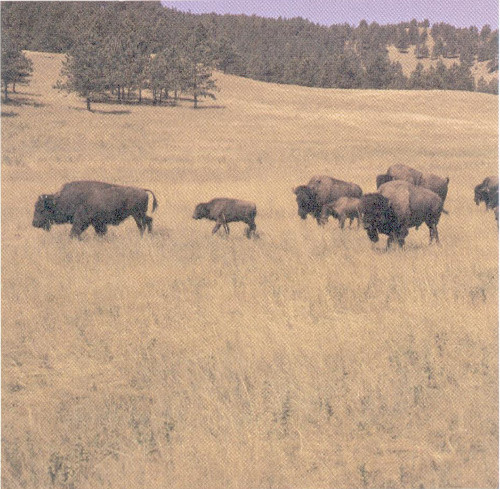
The bison herd at Wind Cave National Park conjures up images of days gone by when as many as 60 million of these animals roamed a 30-state area between the Rockies and the eastern woodlands.
is located on U.S. 16, 24 kilometers (15 miles) west of Custer, South Dakota. Glittering arrays of mineral formations—jewel-like calcite crystals, calcite 75 “popcorn,” crystalline gypsum “flowers”—give this park its name. On the four levels seemingly endless passageways wind on and on, and the end is still not in sight. On the surface in the ponderosa pine forest, you can tell from the dark bark of the young trees why, as one approaches, the Black Hills appear black. Cave tours are conducted daily from mid-May through September. The park does not have overnight accommodations or campgrounds. Mailing address: Custer, South Dakota 57730.
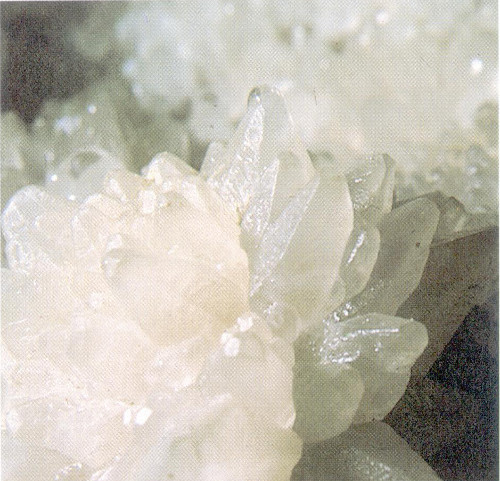
Calcite crystals glisten and sparkle on the walls of Jewel Cave.
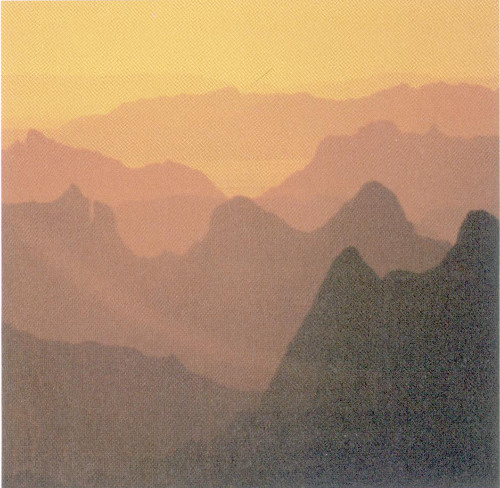
East of Rapid City a different light show can be enjoyed as sunrises and sunsets heighten the natural colors of the eroded rock in Badlands National Park.
is 97 kilometers (60 miles) southeast of Rapid City, South Dakota. Badlands generally describes any deeply eroded and weather-beaten landscape. The play of light and shadow over endless naturally sculpted shapes and the colors of naked rock give these badlands their special beauty. In 1976 a major portion of Badlands National Park was designated wilderness and a new south unit extended the boundaries into the Pine Ridge Indian Reservation. The park has paleontology exhibits, a program on the history of the Oglala Sioux, a variety of nature trails, and a long road system with wayside exhibits at many scenic overlooks. The park has a herd of about 300 bison and some prairie dog towns. It is open all year. Mailing address: Interior, South Dakota 57750.
A considerable distance from Devils Tower, yet related by geography and even history, is a band of national parks not to be overlooked. Yellowstone and Grand Teton in northwestern Wyoming, may, in fact, be your ultimate destination. The snow-capped peaks of the Bighorn Mountains in Wyoming, where Bighorn Canyon National Recreation Area is located, can be seen from several places along the approach road to Devils Tower. Custer Battlefield, adjoining the Crow Indian Reservation, is on the northern route to Yellowstone through Billings, Montana. Theodore Roosevelt National Park celebrates the man and the ideals of the American conservation movement which he accelerated by proclaiming Devils Tower the first national monument.
is on U.S. 89, 90 kilometers (56 miles) south of Livingston, Montana. This first and reigning queen of all national parks, established more than a century ago, draws travelers as if it were a place of pilgrimage. Indeed, there is spiritual enchantment beyond measuring in the lively animation of Yellowstone—its exploding geysers, steaming hot pools, and dashing waters draining both sides of the continent. Between October 31 and May 1, park roads and entrances, except the North Entrance, are ordinarily closed by snow. Winter activities include snowmobiling and cross-country skiing. Campgrounds usually open about June. A host of park-sponsored and concessioner services are offered. Mailing address: Yellowstone National Park, Wyoming 82190.
is located just north of Jackson, Wyoming, on U.S. 187, and 90 kilometers (56 miles) south of Yellowstone via the John D. Rockefeller, Jr., Memorial Parkway. The Tetons, among the noblest creations in the American West, are a congregation of blue-gray pyramids soaring above the sagebrush flats and morainal lakes in Jackson Hole. The valley, a hunting ground of prehistoric Indians for centuries, became a fur trade crossroads in the early 19th Century. Geology, wildlife, plains Indian culture, all share leading roles in the story of this park. Visitor facilities are open all year, though curtailed somewhat in winter. Mailing address: Moose, Wyoming 83021.
is on Interstate 90, 24 kilometers (15 miles) south of Hardin, Montana. On Sunday, June 25, 1876, Lt. Col. George Armstrong Custer and five companies of the 7th Calvary under his immediate command were surrounded and killed by Indians. The defeat shocked the nation and still reverberates with questions about what exactly happened in this clash of cultures. Memorials spread across the hills soberly tell what little is known. The park, open all year, has exhibits but no campgrounds. Mailing address: Crow Agency, Montana 59022.
straddles the Montana-Wyoming boundary, 67 kilometers (42 miles) from Hardin, Montana, on the north: and at Lovell, Wyoming, on the south. Access to boat launching ramps and campgrounds is from either end of the long narrow reservoir backed up behind Yellowtail Dam on the Bighorn River, which here flows north. Boating and fishing enthusiasts enjoy a long season from mid-April to late October. 77 Tours of the dam and powerhouse are given daily from Memorial Day to Labor Day, and the visitor centers are open all year. Mailing address: P.O. Box 458, Fort Smith, Montana 59035.
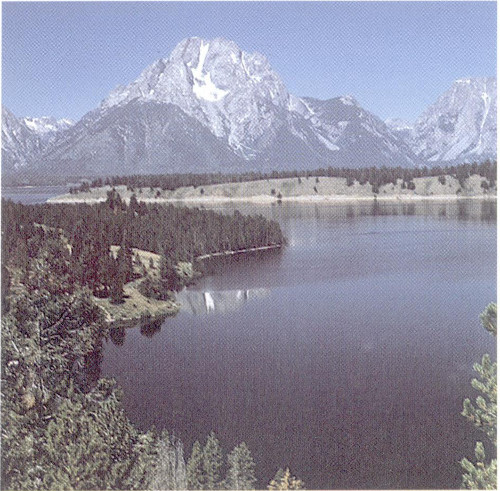
Jackson Lake sits below Mount Moran. This major peak in Grand Teton National Park bears a small permanent glacier.
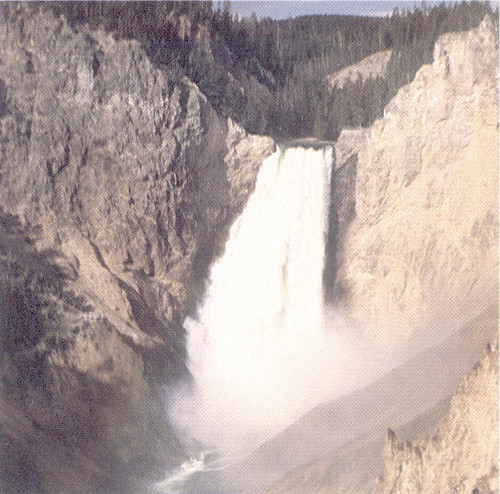
Another celebrated view is the Lower Falls of the Grand Canyon of the Yellowstone, in Yellowstone National Park.
is on Interstate 94, at Medora, North Dakota. A north unit is 90 kilometers (56 miles) north on US. 85. TR’s Maltese Cross Cabin is in the south unit, but the park celebrates more than the 26th President’s energetic protection of public lands. Magnificently colored and worn badlands lie on both sides of the Little Missouri River interspersed with grassy ranges where adventurous men, Roosevelt among them, enterprised in the open-range cattle business. Populations of bighorn sheep, bison, and antelope, among the large game animals once hunted to extinction, have been restored. The visiting season is May through October. The park has campgrounds in both north and south units. Mailing address: Medora, North Dakota 58645.
Books:
Allen, Durward L. The Life of Prairies and Plains. Our Living World of Nature series. McGraw-Hill, 1967.
Everhart, William C. The National Park Service. Praeger Publishers, 1972.
Lamb, Russell, photos by. Wyoming. Graphic Arts Center Publishing Co., 1978.
Larson, T. A. Wyoming—A Bicentennial History. Norton, 1977.
Robbins, Royal. Basic Rockcraft. La Siesta Press, 1971.
Robbins, Royal. Advanced Rockcraft. La Siesta Press, 1973.
Tilden, Freeman. The National Parks. Alfred A. Knopf, 1978.
Tilden, Freeman. Interpreting Our Heritage. University of North Carolina Press, 1977.
Wetmore, Clifford M. Lichens of the Black Hills. Vol. 3, No. 4. Michigan State University, 1968.
Wind Cave. National Park Handbook series, 104. National Park Service, 1979.
Booklets:
Cunningham, Robert. It’s a Dog’s Life. Theodore Roosevelt Nature and History Association, n.d.
Horning, Dennis, and Marriott, Hollis. Free Climbs of Devils Tower. 1980.
Mattison, Ray H. Devils Tower National Monument—A History. Devils Tower Natural History Association, 1981.
Robinson, Charles S. Geology of Devils Tower National Monument, Wyoming. Devils Tower Natural History Association, n.d.
Van Bruggen, Theodore. Wildflowers of the Northern Plains and Black Hills. Badlands Natural History Association, 1976.
Numbers in italics refer to photographs, illustrations, or maps.
A B C D E F G H I J K L M N O P Q R S T U V W X Y Z
For sale by the Superintendent of Documents, U.S. Government Printing Office, Washington, DC 20402.
Stock Number 024-005-00810-1.
★GPO: 1981—341-611/2
The National Park Service expresses its appreciation to all those persons who made the preparation and production of this handbook possible. The Service also gratefully acknowledges the financial support given this handbook project by the Devils Tower Natural History Association a nonprofit group that assists interpretive efforts at Devils Tower National Monument.
Greg Beaumont, who wrote Part 2, is a wildlife photographer and naturalist who lives in Muscatine, Iowa.
R.R. Donnelley & Sons Co. 68.
The prairie dog burrow diagram on page 57 is from the August 1979 issue of “National Geographic” and is used with the permission of the National Geographic Society.
Russell Lamb cover, 6-7, and 22-23.
Greg Beaumont 8, 9, 12, 13, 17, 31 top of Tower, 37-39 except raccoon, 44-45, 54-57, 60, and 61 golden eaglets, coyote, bullsnake, prairie falcon, burrowing owl.
Jaime Quintero 27.
Galen Rowell, Visualeyes Photographic Agency 18, 30, and 31 wood rat, cactus, doves.
Tom Bean 48-49, and 61 badger.
All other illustrations come from the files of Devils Tower National Monument and the National Park Service.
As the Nation’s principal conservation agency, the Department of the Interior has responsibility for most of our nationally owned public lands and natural resources. This includes fostering the wisest use of our land and water resources, protecting our fish and wildlife, preserving the environmental and cultural values of our national parks and historical places, and providing for the enjoyment of these through outdoor recreation. The Department assesses our energy and mineral resources to assure that their development is in the best interest of all our people. The Department also has a major responsibility for American Indian reservation communities and for people who live in island territories under U.S. administration.
End of the Project Gutenberg EBook of Devils Tower National Monument, Wyoming, by
National Park Service
*** END OF THIS PROJECT GUTENBERG EBOOK DEVILS TOWER NATIONAL MONUMENT ***
***** This file should be named 58587-h.htm or 58587-h.zip *****
This and all associated files of various formats will be found in:
http://www.gutenberg.org/5/8/5/8/58587/
Produced by Stephen Hutcheson and the Online Distributed
Proofreading Team at http://www.pgdp.net
Updated editions will replace the previous one--the old editions will
be renamed.
Creating the works from print editions not protected by U.S. copyright
law means that no one owns a United States copyright in these works,
so the Foundation (and you!) can copy and distribute it in the United
States without permission and without paying copyright
royalties. Special rules, set forth in the General Terms of Use part
of this license, apply to copying and distributing Project
Gutenberg-tm electronic works to protect the PROJECT GUTENBERG-tm
concept and trademark. Project Gutenberg is a registered trademark,
and may not be used if you charge for the eBooks, unless you receive
specific permission. If you do not charge anything for copies of this
eBook, complying with the rules is very easy. You may use this eBook
for nearly any purpose such as creation of derivative works, reports,
performances and research. They may be modified and printed and given
away--you may do practically ANYTHING in the United States with eBooks
not protected by U.S. copyright law. Redistribution is subject to the
trademark license, especially commercial redistribution.
START: FULL LICENSE
THE FULL PROJECT GUTENBERG LICENSE
PLEASE READ THIS BEFORE YOU DISTRIBUTE OR USE THIS WORK
To protect the Project Gutenberg-tm mission of promoting the free
distribution of electronic works, by using or distributing this work
(or any other work associated in any way with the phrase "Project
Gutenberg"), you agree to comply with all the terms of the Full
Project Gutenberg-tm License available with this file or online at
www.gutenberg.org/license.
Section 1. General Terms of Use and Redistributing Project
Gutenberg-tm electronic works
1.A. By reading or using any part of this Project Gutenberg-tm
electronic work, you indicate that you have read, understand, agree to
and accept all the terms of this license and intellectual property
(trademark/copyright) agreement. If you do not agree to abide by all
the terms of this agreement, you must cease using and return or
destroy all copies of Project Gutenberg-tm electronic works in your
possession. If you paid a fee for obtaining a copy of or access to a
Project Gutenberg-tm electronic work and you do not agree to be bound
by the terms of this agreement, you may obtain a refund from the
person or entity to whom you paid the fee as set forth in paragraph
1.E.8.
1.B. "Project Gutenberg" is a registered trademark. It may only be
used on or associated in any way with an electronic work by people who
agree to be bound by the terms of this agreement. There are a few
things that you can do with most Project Gutenberg-tm electronic works
even without complying with the full terms of this agreement. See
paragraph 1.C below. There are a lot of things you can do with Project
Gutenberg-tm electronic works if you follow the terms of this
agreement and help preserve free future access to Project Gutenberg-tm
electronic works. See paragraph 1.E below.
1.C. The Project Gutenberg Literary Archive Foundation ("the
Foundation" or PGLAF), owns a compilation copyright in the collection
of Project Gutenberg-tm electronic works. Nearly all the individual
works in the collection are in the public domain in the United
States. If an individual work is unprotected by copyright law in the
United States and you are located in the United States, we do not
claim a right to prevent you from copying, distributing, performing,
displaying or creating derivative works based on the work as long as
all references to Project Gutenberg are removed. Of course, we hope
that you will support the Project Gutenberg-tm mission of promoting
free access to electronic works by freely sharing Project Gutenberg-tm
works in compliance with the terms of this agreement for keeping the
Project Gutenberg-tm name associated with the work. You can easily
comply with the terms of this agreement by keeping this work in the
same format with its attached full Project Gutenberg-tm License when
you share it without charge with others.
1.D. The copyright laws of the place where you are located also govern
what you can do with this work. Copyright laws in most countries are
in a constant state of change. If you are outside the United States,
check the laws of your country in addition to the terms of this
agreement before downloading, copying, displaying, performing,
distributing or creating derivative works based on this work or any
other Project Gutenberg-tm work. The Foundation makes no
representations concerning the copyright status of any work in any
country outside the United States.
1.E. Unless you have removed all references to Project Gutenberg:
1.E.1. The following sentence, with active links to, or other
immediate access to, the full Project Gutenberg-tm License must appear
prominently whenever any copy of a Project Gutenberg-tm work (any work
on which the phrase "Project Gutenberg" appears, or with which the
phrase "Project Gutenberg" is associated) is accessed, displayed,
performed, viewed, copied or distributed:
This eBook is for the use of anyone anywhere in the United States and
most other parts of the world at no cost and with almost no
restrictions whatsoever. You may copy it, give it away or re-use it
under the terms of the Project Gutenberg License included with this
eBook or online at www.gutenberg.org. If you are not located in the
United States, you'll have to check the laws of the country where you
are located before using this ebook.
1.E.2. If an individual Project Gutenberg-tm electronic work is
derived from texts not protected by U.S. copyright law (does not
contain a notice indicating that it is posted with permission of the
copyright holder), the work can be copied and distributed to anyone in
the United States without paying any fees or charges. If you are
redistributing or providing access to a work with the phrase "Project
Gutenberg" associated with or appearing on the work, you must comply
either with the requirements of paragraphs 1.E.1 through 1.E.7 or
obtain permission for the use of the work and the Project Gutenberg-tm
trademark as set forth in paragraphs 1.E.8 or 1.E.9.
1.E.3. If an individual Project Gutenberg-tm electronic work is posted
with the permission of the copyright holder, your use and distribution
must comply with both paragraphs 1.E.1 through 1.E.7 and any
additional terms imposed by the copyright holder. Additional terms
will be linked to the Project Gutenberg-tm License for all works
posted with the permission of the copyright holder found at the
beginning of this work.
1.E.4. Do not unlink or detach or remove the full Project Gutenberg-tm
License terms from this work, or any files containing a part of this
work or any other work associated with Project Gutenberg-tm.
1.E.5. Do not copy, display, perform, distribute or redistribute this
electronic work, or any part of this electronic work, without
prominently displaying the sentence set forth in paragraph 1.E.1 with
active links or immediate access to the full terms of the Project
Gutenberg-tm License.
1.E.6. You may convert to and distribute this work in any binary,
compressed, marked up, nonproprietary or proprietary form, including
any word processing or hypertext form. However, if you provide access
to or distribute copies of a Project Gutenberg-tm work in a format
other than "Plain Vanilla ASCII" or other format used in the official
version posted on the official Project Gutenberg-tm web site
(www.gutenberg.org), you must, at no additional cost, fee or expense
to the user, provide a copy, a means of exporting a copy, or a means
of obtaining a copy upon request, of the work in its original "Plain
Vanilla ASCII" or other form. Any alternate format must include the
full Project Gutenberg-tm License as specified in paragraph 1.E.1.
1.E.7. Do not charge a fee for access to, viewing, displaying,
performing, copying or distributing any Project Gutenberg-tm works
unless you comply with paragraph 1.E.8 or 1.E.9.
1.E.8. You may charge a reasonable fee for copies of or providing
access to or distributing Project Gutenberg-tm electronic works
provided that
* You pay a royalty fee of 20% of the gross profits you derive from
the use of Project Gutenberg-tm works calculated using the method
you already use to calculate your applicable taxes. The fee is owed
to the owner of the Project Gutenberg-tm trademark, but he has
agreed to donate royalties under this paragraph to the Project
Gutenberg Literary Archive Foundation. Royalty payments must be paid
within 60 days following each date on which you prepare (or are
legally required to prepare) your periodic tax returns. Royalty
payments should be clearly marked as such and sent to the Project
Gutenberg Literary Archive Foundation at the address specified in
Section 4, "Information about donations to the Project Gutenberg
Literary Archive Foundation."
* You provide a full refund of any money paid by a user who notifies
you in writing (or by e-mail) within 30 days of receipt that s/he
does not agree to the terms of the full Project Gutenberg-tm
License. You must require such a user to return or destroy all
copies of the works possessed in a physical medium and discontinue
all use of and all access to other copies of Project Gutenberg-tm
works.
* You provide, in accordance with paragraph 1.F.3, a full refund of
any money paid for a work or a replacement copy, if a defect in the
electronic work is discovered and reported to you within 90 days of
receipt of the work.
* You comply with all other terms of this agreement for free
distribution of Project Gutenberg-tm works.
1.E.9. If you wish to charge a fee or distribute a Project
Gutenberg-tm electronic work or group of works on different terms than
are set forth in this agreement, you must obtain permission in writing
from both the Project Gutenberg Literary Archive Foundation and The
Project Gutenberg Trademark LLC, the owner of the Project Gutenberg-tm
trademark. Contact the Foundation as set forth in Section 3 below.
1.F.
1.F.1. Project Gutenberg volunteers and employees expend considerable
effort to identify, do copyright research on, transcribe and proofread
works not protected by U.S. copyright law in creating the Project
Gutenberg-tm collection. Despite these efforts, Project Gutenberg-tm
electronic works, and the medium on which they may be stored, may
contain "Defects," such as, but not limited to, incomplete, inaccurate
or corrupt data, transcription errors, a copyright or other
intellectual property infringement, a defective or damaged disk or
other medium, a computer virus, or computer codes that damage or
cannot be read by your equipment.
1.F.2. LIMITED WARRANTY, DISCLAIMER OF DAMAGES - Except for the "Right
of Replacement or Refund" described in paragraph 1.F.3, the Project
Gutenberg Literary Archive Foundation, the owner of the Project
Gutenberg-tm trademark, and any other party distributing a Project
Gutenberg-tm electronic work under this agreement, disclaim all
liability to you for damages, costs and expenses, including legal
fees. YOU AGREE THAT YOU HAVE NO REMEDIES FOR NEGLIGENCE, STRICT
LIABILITY, BREACH OF WARRANTY OR BREACH OF CONTRACT EXCEPT THOSE
PROVIDED IN PARAGRAPH 1.F.3. YOU AGREE THAT THE FOUNDATION, THE
TRADEMARK OWNER, AND ANY DISTRIBUTOR UNDER THIS AGREEMENT WILL NOT BE
LIABLE TO YOU FOR ACTUAL, DIRECT, INDIRECT, CONSEQUENTIAL, PUNITIVE OR
INCIDENTAL DAMAGES EVEN IF YOU GIVE NOTICE OF THE POSSIBILITY OF SUCH
DAMAGE.
1.F.3. LIMITED RIGHT OF REPLACEMENT OR REFUND - If you discover a
defect in this electronic work within 90 days of receiving it, you can
receive a refund of the money (if any) you paid for it by sending a
written explanation to the person you received the work from. If you
received the work on a physical medium, you must return the medium
with your written explanation. The person or entity that provided you
with the defective work may elect to provide a replacement copy in
lieu of a refund. If you received the work electronically, the person
or entity providing it to you may choose to give you a second
opportunity to receive the work electronically in lieu of a refund. If
the second copy is also defective, you may demand a refund in writing
without further opportunities to fix the problem.
1.F.4. Except for the limited right of replacement or refund set forth
in paragraph 1.F.3, this work is provided to you 'AS-IS', WITH NO
OTHER WARRANTIES OF ANY KIND, EXPRESS OR IMPLIED, INCLUDING BUT NOT
LIMITED TO WARRANTIES OF MERCHANTABILITY OR FITNESS FOR ANY PURPOSE.
1.F.5. Some states do not allow disclaimers of certain implied
warranties or the exclusion or limitation of certain types of
damages. If any disclaimer or limitation set forth in this agreement
violates the law of the state applicable to this agreement, the
agreement shall be interpreted to make the maximum disclaimer or
limitation permitted by the applicable state law. The invalidity or
unenforceability of any provision of this agreement shall not void the
remaining provisions.
1.F.6. INDEMNITY - You agree to indemnify and hold the Foundation, the
trademark owner, any agent or employee of the Foundation, anyone
providing copies of Project Gutenberg-tm electronic works in
accordance with this agreement, and any volunteers associated with the
production, promotion and distribution of Project Gutenberg-tm
electronic works, harmless from all liability, costs and expenses,
including legal fees, that arise directly or indirectly from any of
the following which you do or cause to occur: (a) distribution of this
or any Project Gutenberg-tm work, (b) alteration, modification, or
additions or deletions to any Project Gutenberg-tm work, and (c) any
Defect you cause.
Section 2. Information about the Mission of Project Gutenberg-tm
Project Gutenberg-tm is synonymous with the free distribution of
electronic works in formats readable by the widest variety of
computers including obsolete, old, middle-aged and new computers. It
exists because of the efforts of hundreds of volunteers and donations
from people in all walks of life.
Volunteers and financial support to provide volunteers with the
assistance they need are critical to reaching Project Gutenberg-tm's
goals and ensuring that the Project Gutenberg-tm collection will
remain freely available for generations to come. In 2001, the Project
Gutenberg Literary Archive Foundation was created to provide a secure
and permanent future for Project Gutenberg-tm and future
generations. To learn more about the Project Gutenberg Literary
Archive Foundation and how your efforts and donations can help, see
Sections 3 and 4 and the Foundation information page at
www.gutenberg.org
Section 3. Information about the Project Gutenberg Literary Archive Foundation
The Project Gutenberg Literary Archive Foundation is a non profit
501(c)(3) educational corporation organized under the laws of the
state of Mississippi and granted tax exempt status by the Internal
Revenue Service. The Foundation's EIN or federal tax identification
number is 64-6221541. Contributions to the Project Gutenberg Literary
Archive Foundation are tax deductible to the full extent permitted by
U.S. federal laws and your state's laws.
The Foundation's principal office is in Fairbanks, Alaska, with the
mailing address: PO Box 750175, Fairbanks, AK 99775, but its
volunteers and employees are scattered throughout numerous
locations. Its business office is located at 809 North 1500 West, Salt
Lake City, UT 84116, (801) 596-1887. Email contact links and up to
date contact information can be found at the Foundation's web site and
official page at www.gutenberg.org/contact
For additional contact information:
Dr. Gregory B. Newby
Chief Executive and Director
gbnewby@pglaf.org
Section 4. Information about Donations to the Project Gutenberg
Literary Archive Foundation
Project Gutenberg-tm depends upon and cannot survive without wide
spread public support and donations to carry out its mission of
increasing the number of public domain and licensed works that can be
freely distributed in machine readable form accessible by the widest
array of equipment including outdated equipment. Many small donations
($1 to $5,000) are particularly important to maintaining tax exempt
status with the IRS.
The Foundation is committed to complying with the laws regulating
charities and charitable donations in all 50 states of the United
States. Compliance requirements are not uniform and it takes a
considerable effort, much paperwork and many fees to meet and keep up
with these requirements. We do not solicit donations in locations
where we have not received written confirmation of compliance. To SEND
DONATIONS or determine the status of compliance for any particular
state visit www.gutenberg.org/donate
While we cannot and do not solicit contributions from states where we
have not met the solicitation requirements, we know of no prohibition
against accepting unsolicited donations from donors in such states who
approach us with offers to donate.
International donations are gratefully accepted, but we cannot make
any statements concerning tax treatment of donations received from
outside the United States. U.S. laws alone swamp our small staff.
Please check the Project Gutenberg Web pages for current donation
methods and addresses. Donations are accepted in a number of other
ways including checks, online payments and credit card donations. To
donate, please visit: www.gutenberg.org/donate
Section 5. General Information About Project Gutenberg-tm electronic works.
Professor Michael S. Hart was the originator of the Project
Gutenberg-tm concept of a library of electronic works that could be
freely shared with anyone. For forty years, he produced and
distributed Project Gutenberg-tm eBooks with only a loose network of
volunteer support.
Project Gutenberg-tm eBooks are often created from several printed
editions, all of which are confirmed as not protected by copyright in
the U.S. unless a copyright notice is included. Thus, we do not
necessarily keep eBooks in compliance with any particular paper
edition.
Most people start at our Web site which has the main PG search
facility: www.gutenberg.org
This Web site includes information about Project Gutenberg-tm,
including how to make donations to the Project Gutenberg Literary
Archive Foundation, how to help produce our new eBooks, and how to
subscribe to our email newsletter to hear about new eBooks.